- Home
- Find Gizmos
- Browse by Standard (USA)
- Mississippi Standards
- Mathematics: Algebra 2
Mississippi - Mathematics: Algebra 2
College- and Career-Readiness Standards | Adopted: 2016
N: : Number and Quantity
N-RN: : The Real Number System
1.1.1: : Extend the properties of exponents to rational exponents
N-RN.1: : Explain how the definition of the meaning of rational exponents follows from extending the properties of integer exponents to those values, allowing for a notation for radicals in terms of rational exponents.
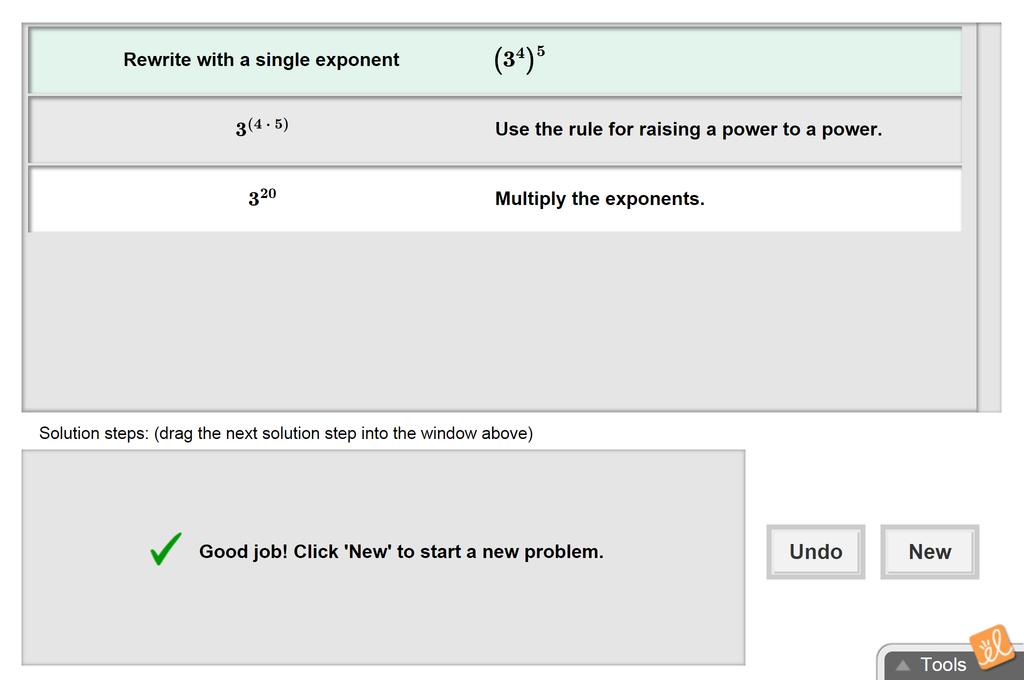
Exponents and Power Rules
Choose the correct steps to simplify expressions with exponents using the rules of exponents and powers. Use feedback to diagnose incorrect steps. 5 Minute Preview
N-CN: : The Complex Number System
1.3.1: : Perform arithmetic operations with complex numbers
N-CN.1: : Know there is a complex number i such that i² = –1, and every complex number has the form a + bi with a and b real.

Points in the Complex Plane
Identify the imaginary and real coordinates of a point in the complex plane. Drag the point in the plane and investigate how the coordinates change in response. 5 Minute Preview

Roots of a Quadratic
Find the root of a quadratic using its graph or the quadratic formula. Explore the graph of the roots and the point of symmetry in the complex plane. Compare the axis of symmetry and graph of the quadratic in the real plane. 5 Minute Preview
N-CN.2: : Use the relation ??² = –1 and the commutative, associative, and distributive properties to add, subtract, and multiply complex numbers.

Points in the Complex Plane
Identify the imaginary and real coordinates of a point in the complex plane. Drag the point in the plane and investigate how the coordinates change in response. 5 Minute Preview
1.3.2: : Use complex numbers in polynomial identities and equations
N-CN.7: : Solve quadratic equations with real coefficients that have complex solutions.

Points in the Complex Plane
Identify the imaginary and real coordinates of a point in the complex plane. Drag the point in the plane and investigate how the coordinates change in response. 5 Minute Preview

Roots of a Quadratic
Find the root of a quadratic using its graph or the quadratic formula. Explore the graph of the roots and the point of symmetry in the complex plane. Compare the axis of symmetry and graph of the quadratic in the real plane. 5 Minute Preview
A: : Algebra
A-SSE: : Seeing Structure in Expressions
2.1.1: : Interpret the structure of expressions
A-SSE.2: : Use the structure of an expression to identify ways to rewrite it.
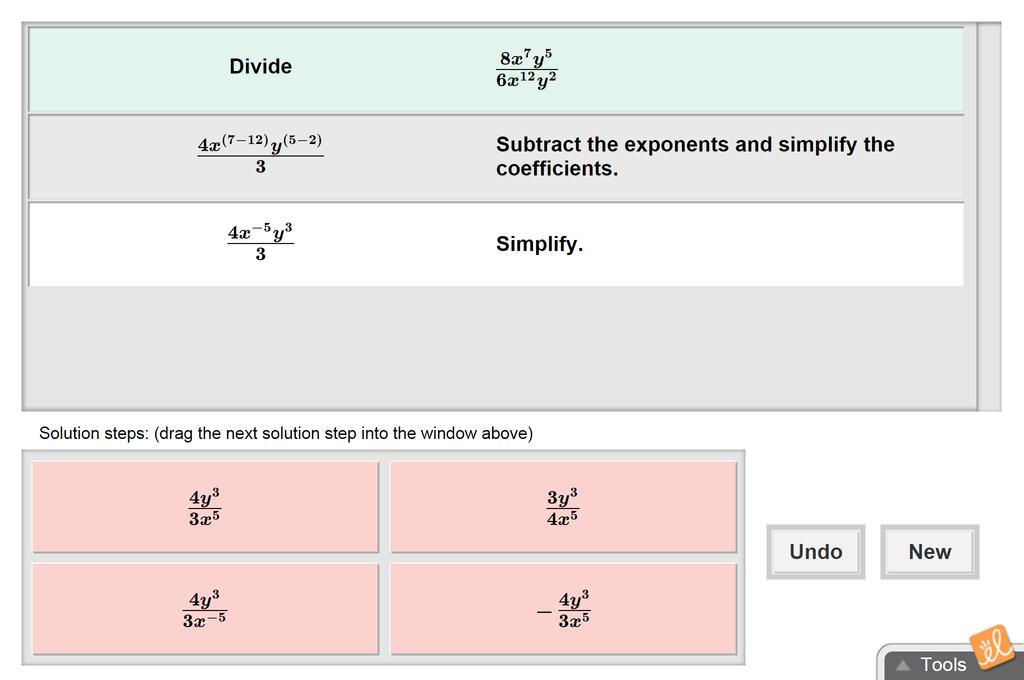
Dividing Exponential Expressions
Choose the correct steps to divide exponential expressions. Use the feedback to diagnose incorrect steps. 5 Minute Preview
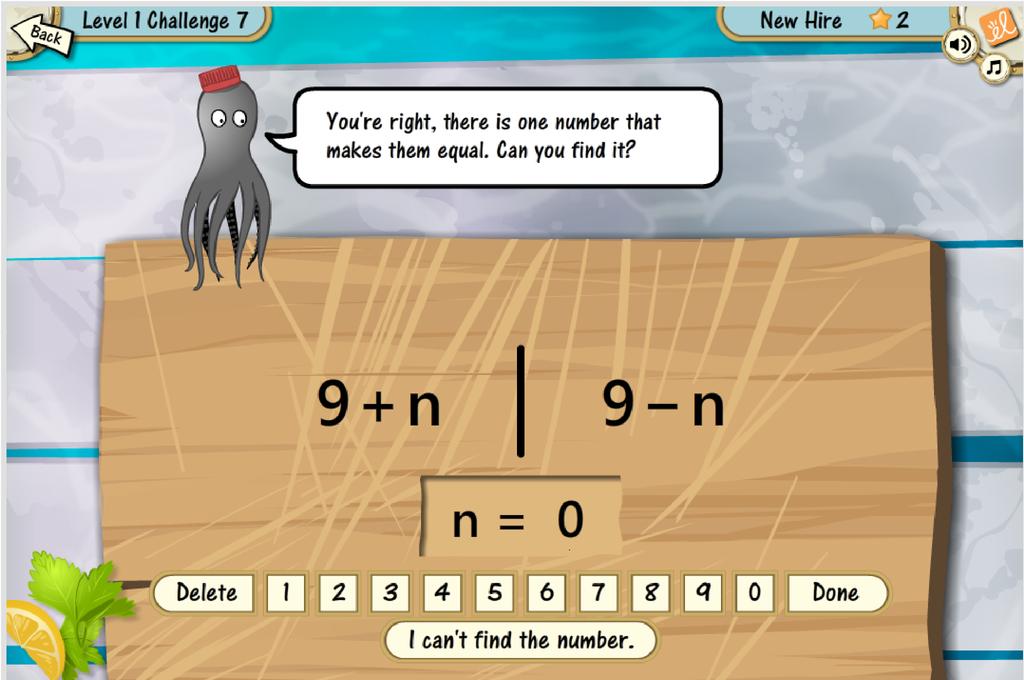
Equivalent Algebraic Expressions I
Grumpy’s Restaurant is now hiring! As a new chef at this underwater bistro, you’ll learn the basics of manipulating algebraic expressions. Learn how to make equivalent expressions using the Commutative and Associative properties, how to handle pesky subtraction and division, and how to identify equivalent and non-equivalent expressions. 5 Minute Preview
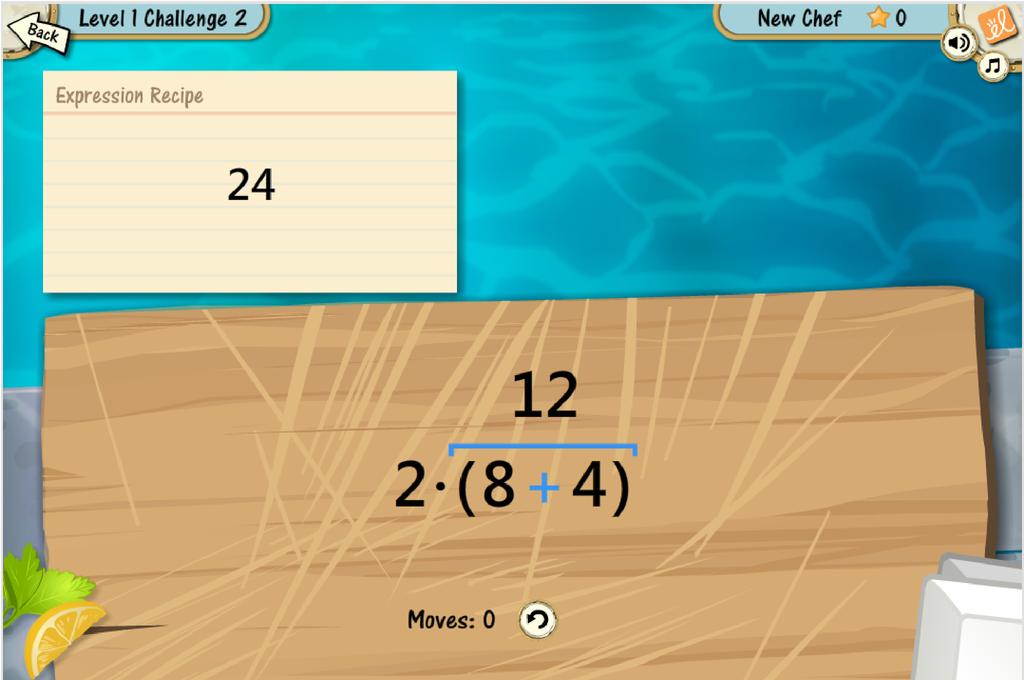
Equivalent Algebraic Expressions II
Continue your meteoric rise in the undersea culinary world in this follow-up to Equivalent Algebraic Expressions I. Make equivalent expressions by using the distributive property forwards and backwards, sort expressions by equivalence, and personally assist Chef Grumpy himself with a project that will bring him (and maybe you) fame and fortune. 5 Minute Preview

Exponents and Power Rules
Choose the correct steps to simplify expressions with exponents using the rules of exponents and powers. Use feedback to diagnose incorrect steps. 5 Minute Preview
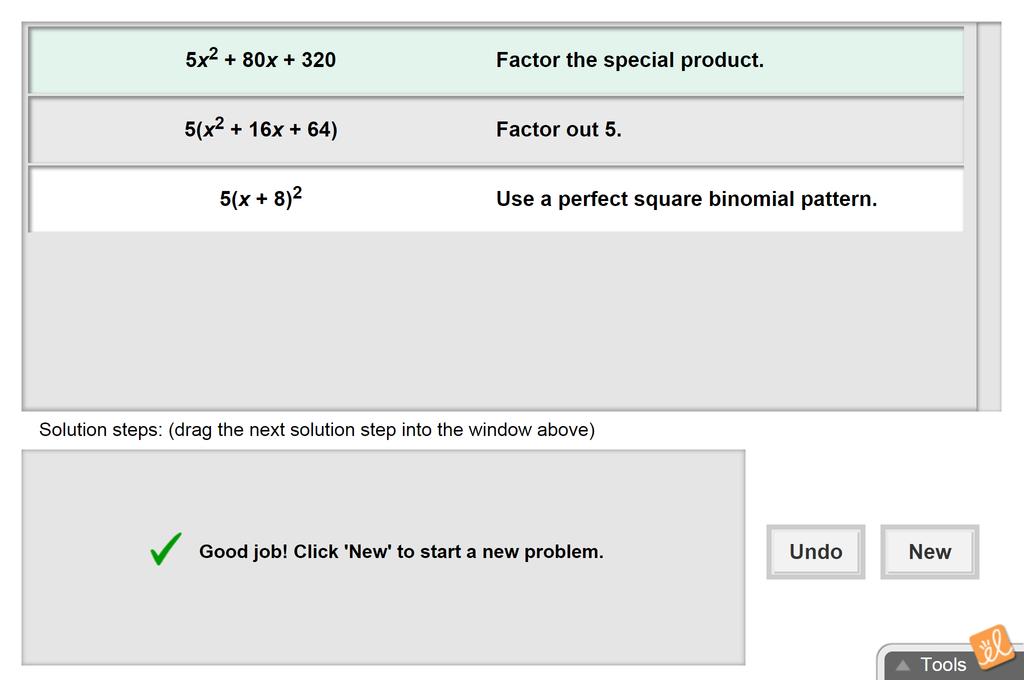
Factoring Special Products
Choose the correct steps to factor a polynomial involving perfect-square binomials, differences of squares, or constant factors. Use the feedback to diagnose incorrect steps. 5 Minute Preview
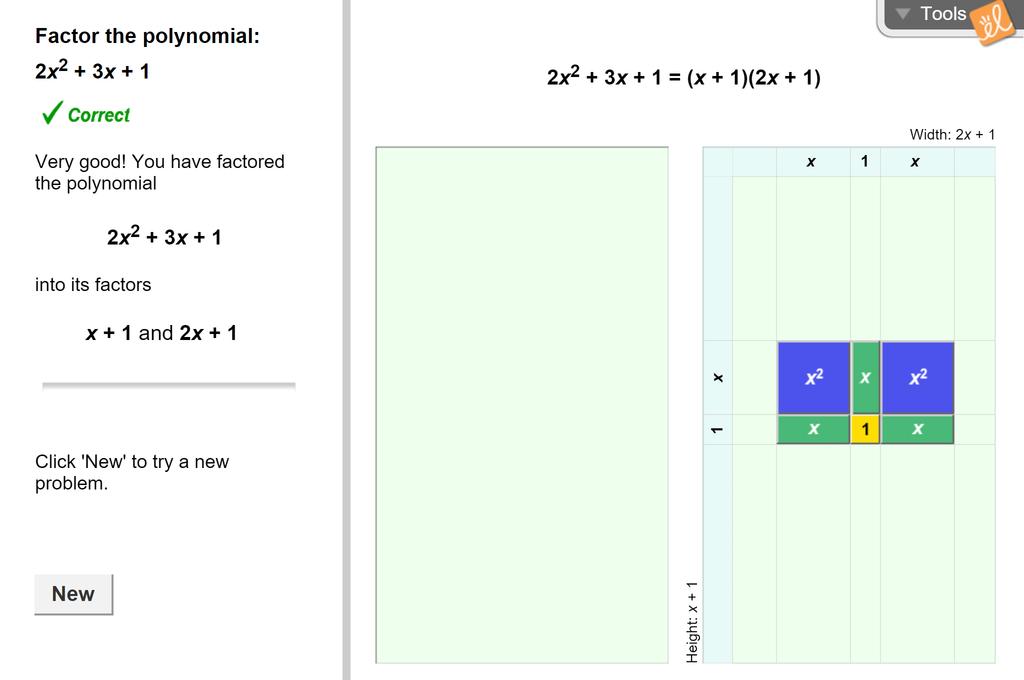
Modeling the Factorization of ax2+bx+c
Factor a polynomial with a leading coefficient greater than 1 using an area model. Use step-by-step feedback to diagnose any mistakes. 5 Minute Preview

Modeling the Factorization of x2+bx+c
Factor a polynomial with a leading coefficient equal to 1 using an area model. Use step-by-step feedback to diagnose any mistakes. 5 Minute Preview
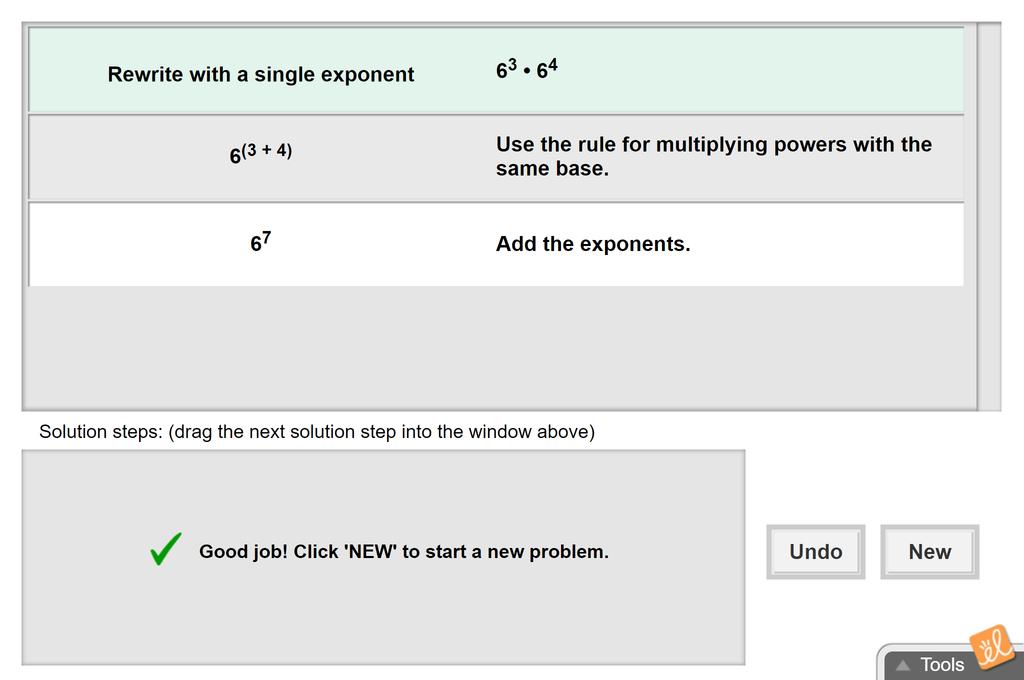
Multiplying Exponential Expressions
Choose the correct steps to multiply exponential expressions. Use the feedback to diagnose incorrect steps. 5 Minute Preview
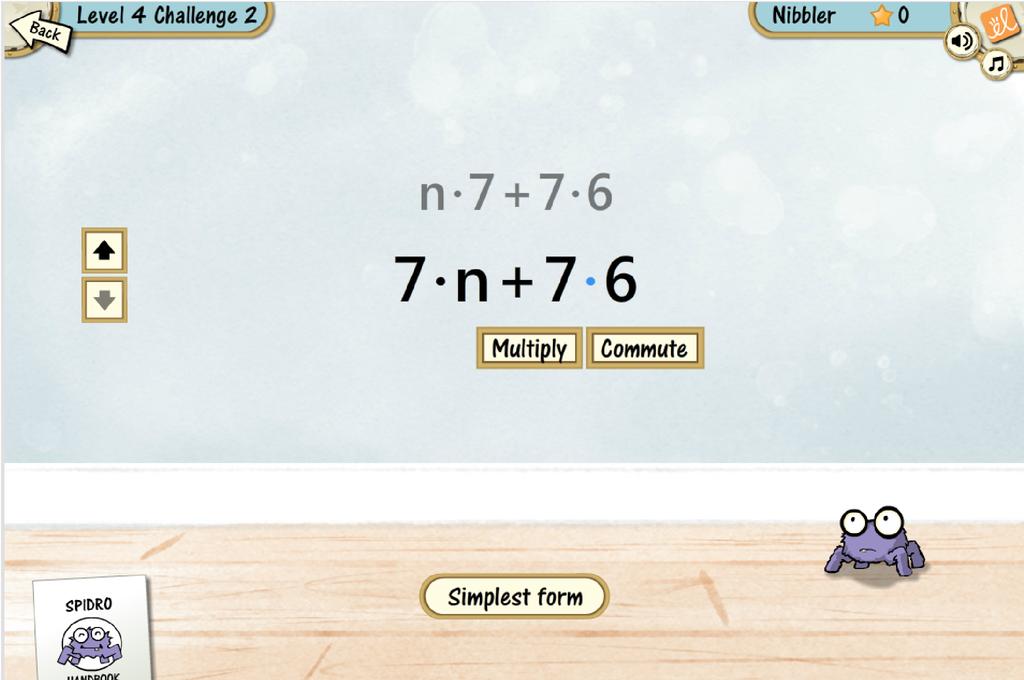
Simplifying Algebraic Expressions I
Meet Spidro, a quirky critter with an appetite for algebraic expressions! As Spidro's adopted owner, it's your responsibility to feed him so that he grows into… whatever it is that a Spidro grows into. But be careful - Spidro is a picky eater who prefers his food to be as simple as possible. Use the commutative property, distributive property, and the other properties of addition and multiplication to put expressions in simplest (and tastiest) form. 5 Minute Preview
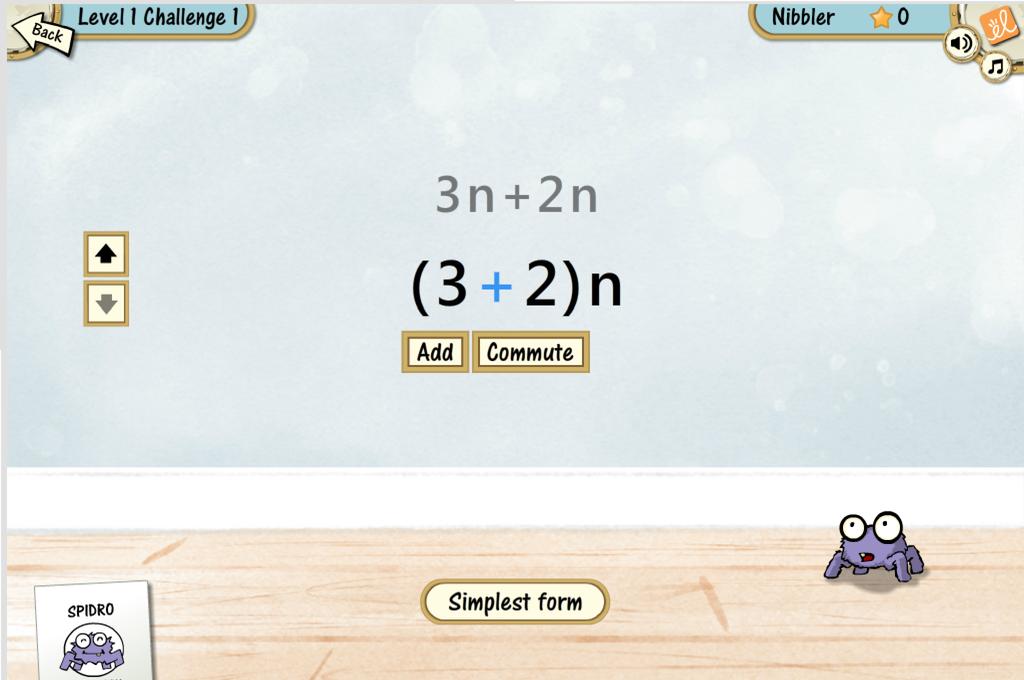
Simplifying Algebraic Expressions II
Will you adopt Spidro, Centeon, or Ping Bee? They're three very different critters with one thing in common: a hunger for simplified algebraic expressions! Learn how the distributive property can be used to combine variable terms, producing expressions that will help your pet grow up healthy and strong. You'll become a pro at identifying terms that can be combined – even terms with exponents and multiple variables. With enough practice, you and your pet will be ready for the competitive expression eating circuit. Good luck! 5 Minute Preview
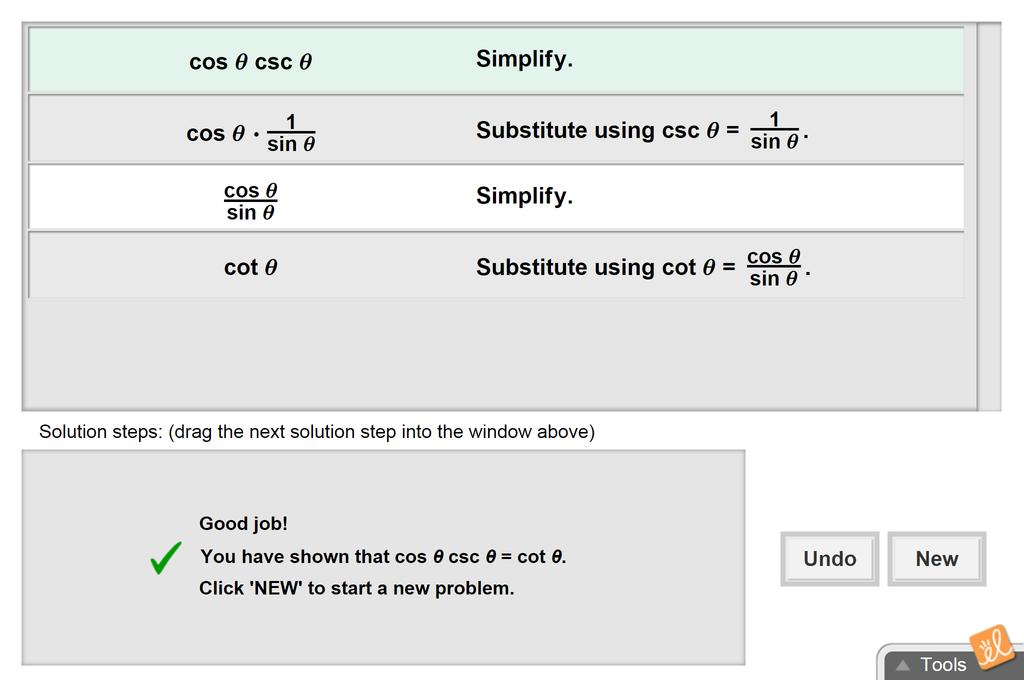
Simplifying Trigonometric Expressions
Choose the correct steps to simplify a trigonometric function. Use step-by-step feedback to diagnose incorrect steps. 5 Minute Preview

Solving Algebraic Equations II
Is solving equations tricky? If you know how to isolate a variable, you're halfway there. The other half? Don't do anything to upset the balance of an equation. Join our plucky variable friend as he encounters algebraic equations and a (sometimes grumpy) equal sign. With a little practice, you'll find that solving equations isn't tricky at all. 5 Minute Preview

Using Algebraic Expressions
Translate algebraic expressions into English phrases, and translate English phrases into algebraic expressions. Read the expression or phrase and select word tiles or symbol tiles to form the corresponding phrase or expression. 5 Minute Preview
2.1.2: : Write expressions in equivalent forms to solve problems
A-SSE.3: : Choose and produce an equivalent form of an expression to reveal and explain properties of the quantity represented by the expression.
A-SSE.3c: : Use the properties of exponents to transform expressions for exponential functions.

Dividing Exponential Expressions
Choose the correct steps to divide exponential expressions. Use the feedback to diagnose incorrect steps. 5 Minute Preview

Exponents and Power Rules
Choose the correct steps to simplify expressions with exponents using the rules of exponents and powers. Use feedback to diagnose incorrect steps. 5 Minute Preview
A-APR: : Arithmetic with Polynomials and Rational Expressions
2.2.1: : Understand the relationship between zeros and factors of polynomials
A-APR.2: : Know and apply the Remainder Theorem: For a polynomial p(x) and a number a, the remainder on division by x – a is p(a), so p(a) = 0 if and only if (x – a) is a factor of p(x).

Dividing Polynomials Using Synthetic Division
Divide a polynomial by dragging the correct numbers into the correct positions for synthetic division. Compare the interpreted polynomial division to the synthetic division. 5 Minute Preview
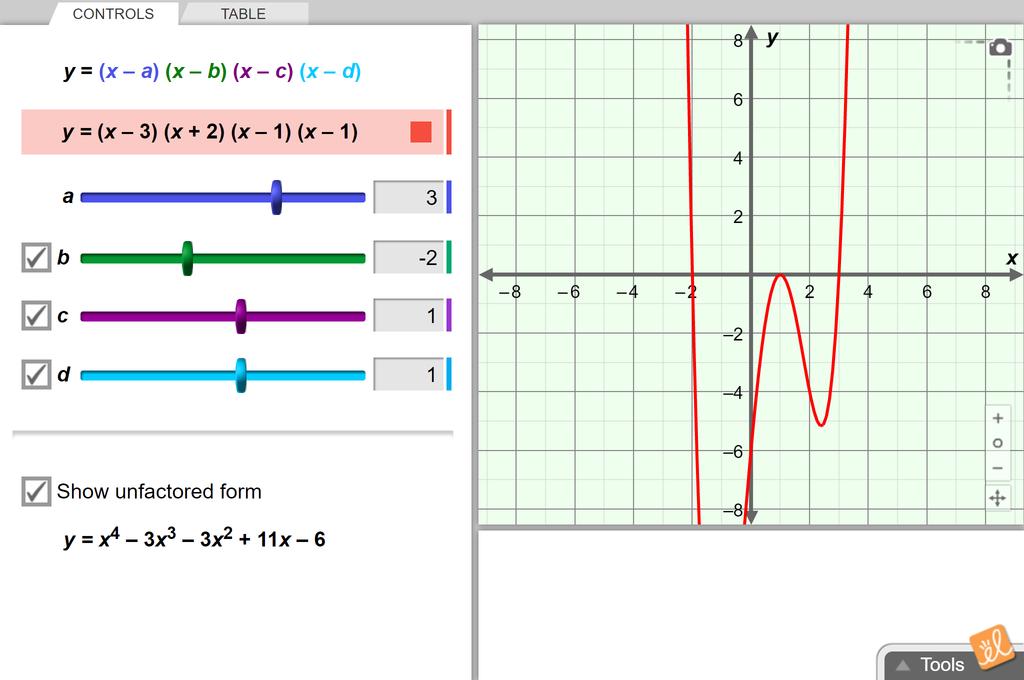
Polynomials and Linear Factors
Create a polynomial as a product of linear factors. Vary the values in the linear factors to see how their connection to the roots of the function. 5 Minute Preview
A-APR.3: : Identify zeros of polynomials when suitable factorizations are available, and use the zeros to construct a rough graph of the function defined by the polynomial (limit to 1st- and 2nd-degree polynomials).
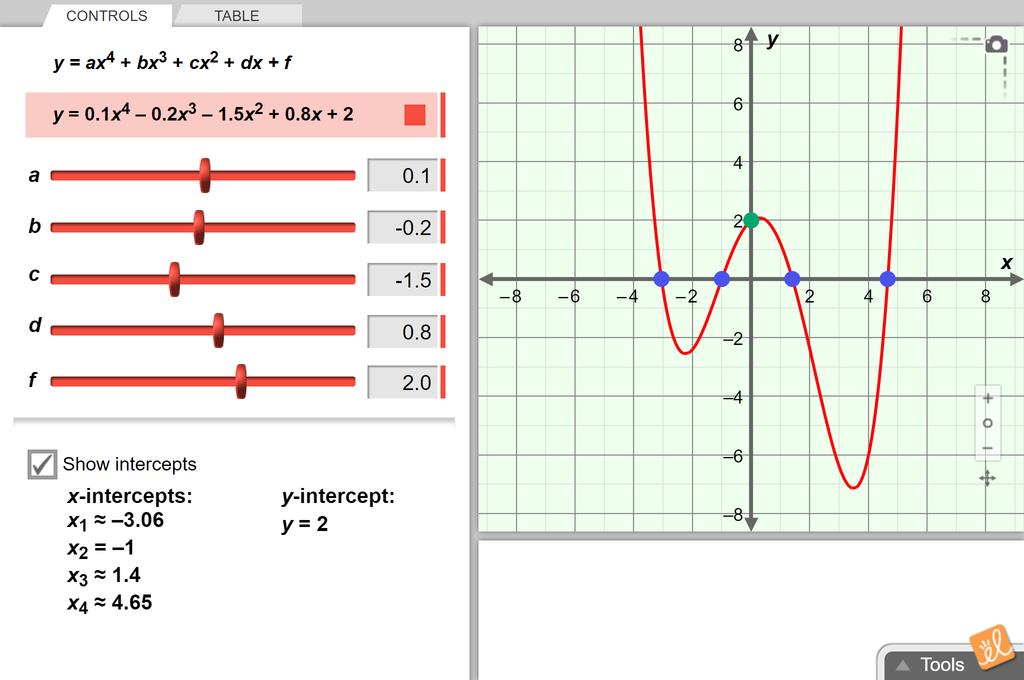
Graphs of Polynomial Functions
Study the graphs of polynomials up to the fourth degree. Vary the coefficients of the equation and investigate how the graph changes in response. Explore things like intercepts, end behavior, and even near-zero behavior. 5 Minute Preview

Modeling the Factorization of x2+bx+c
Factor a polynomial with a leading coefficient equal to 1 using an area model. Use step-by-step feedback to diagnose any mistakes. 5 Minute Preview

Polynomials and Linear Factors
Create a polynomial as a product of linear factors. Vary the values in the linear factors to see how their connection to the roots of the function. 5 Minute Preview
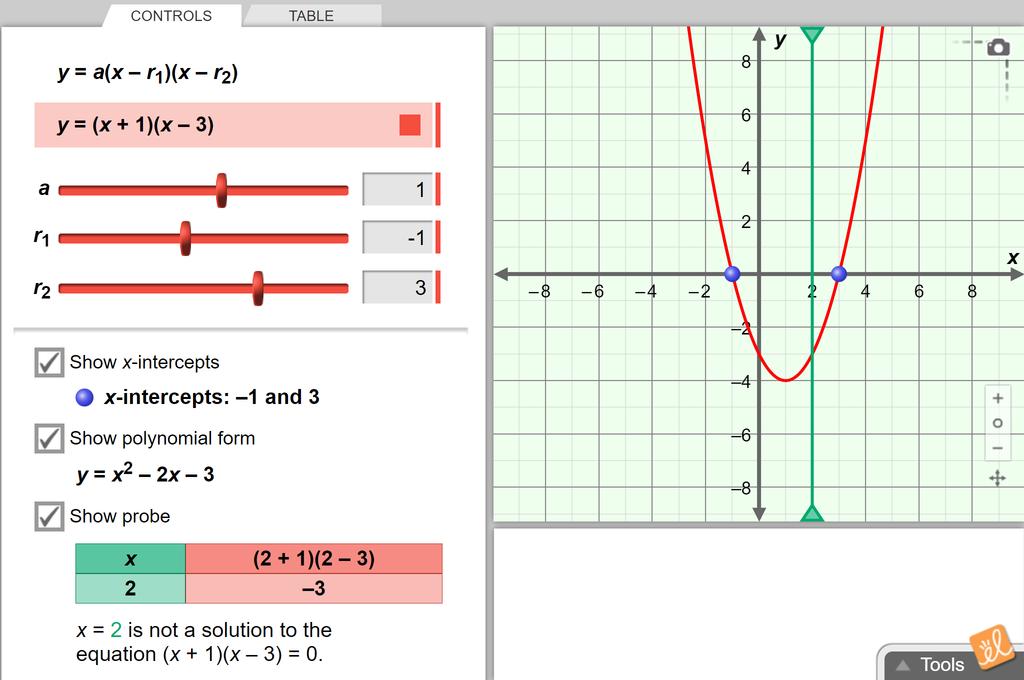
Quadratics in Factored Form
Investigate the factors of a quadratic through its graph and through its equation. Vary the roots of the quadratic and examine how the graph and the equation change in response. 5 Minute Preview

Quadratics in Vertex Form
Compare the graph of a quadratic to its equation in vertex form. Vary the terms of the equation and explore how the graph changes in response. 5 Minute Preview
2.2.2: : Use polynomial identities to solve problems
A-APR.4: : Prove polynomial identities and use them to describe numerical relationships.

Factoring Special Products
Choose the correct steps to factor a polynomial involving perfect-square binomials, differences of squares, or constant factors. Use the feedback to diagnose incorrect steps. 5 Minute Preview
A-CED: : Creating Equations
2.3.1: : Create equations that describe numbers or relationships
A-CED.1: : Create equations and inequalities in one variable and use them to solve problems.
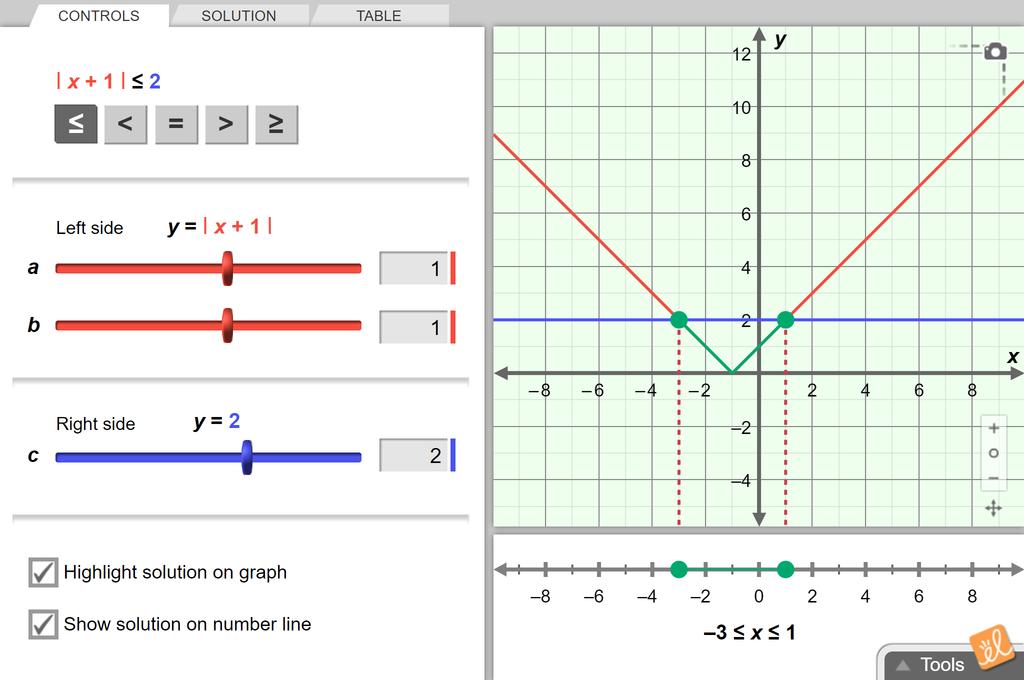
Absolute Value Equations and Inequalities
Solve an inequality involving absolute values using a graph of the absolute-value function. Vary the terms of the absolute-value function and vary the value that you are comparing it to. Then explore how the graph and solution set change in response. 5 Minute Preview

Arithmetic Sequences
Find the value of individual terms in arithmetic sequences using graphs of the sequences and direct computation. Vary the common difference and examine how the sequences change in response. 5 Minute Preview

Compound Interest
Explore compound interest in-depth, from compounded annually to compounded continuously. In addition, compare the END POINTS graph, with dots that fit an exponential curve, to the ALL TIME graph, which has a more step-like appearance. 5 Minute Preview

Exploring Linear Inequalities in One Variable
Solve inequalities in one variable. Examine the inequality on a number line and determine which points are solutions to the inequality. 5 Minute Preview

Geometric Sequences
Explore geometric sequences by varying the initial term and the common ratio and examining the graph. Compute specific terms in the sequence using the explicit and recursive formulas. 5 Minute Preview
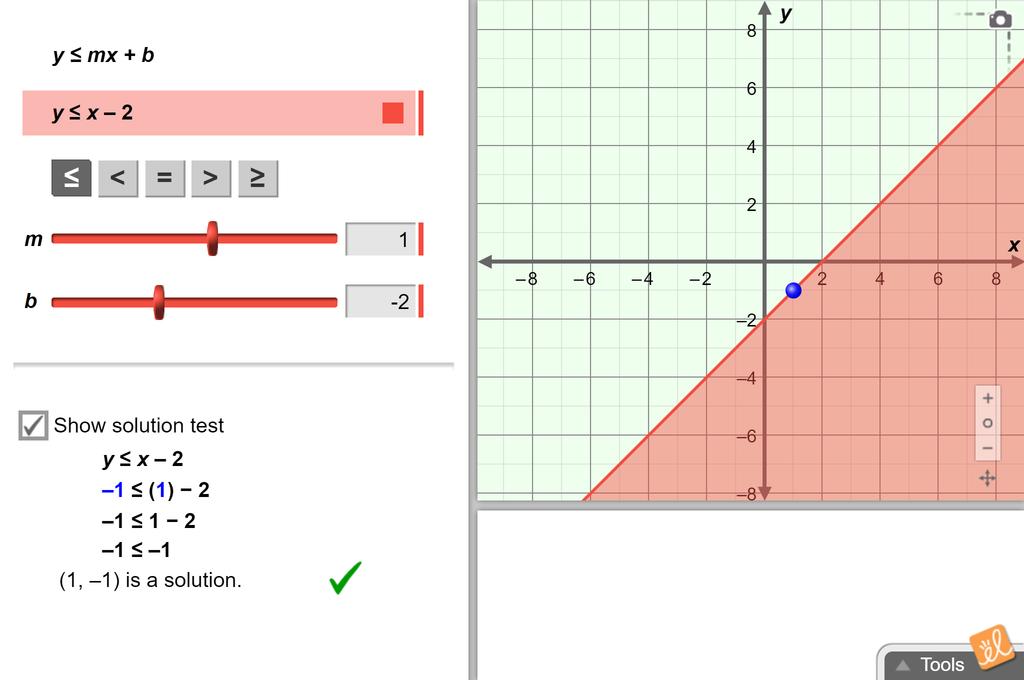
Linear Inequalities in Two Variables
Find the solution set to a linear inequality in two variables using the graph of the linear inequality. Vary the terms of the inequality and vary the inequality symbol. Examine how the boundary line and shaded region change in response. 5 Minute Preview

Modeling One-Step Equations
Solve a linear equation using a tile model. Use feedback to diagnose incorrect steps. 5 Minute Preview

Modeling and Solving Two-Step Equations
Solve a two-step equation using a cup-and-counter model. Use step-by-step feedback to diagnose and correct incorrect steps. 5 Minute Preview
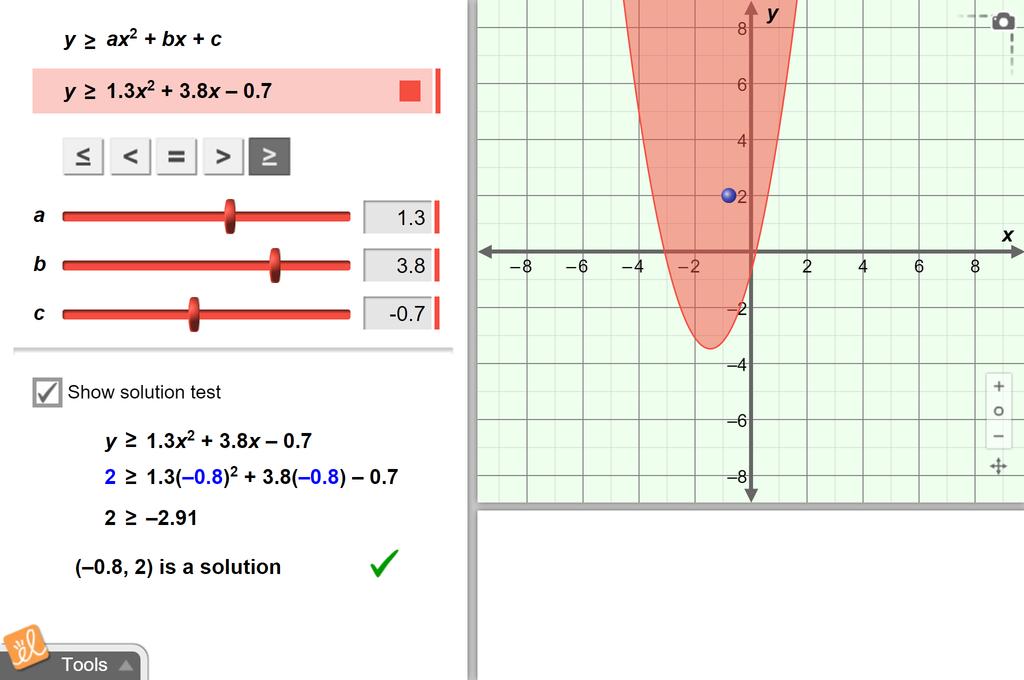
Quadratic Inequalities
Find the solution set to a quadratic inequality using its graph. Vary the terms of the inequality and the inequality symbol. Examine how the boundary curve and shaded region change in response. 5 Minute Preview

Solving Equations on the Number Line
Solve an equation involving decimals using dynamic arrows on a number line. 5 Minute Preview

Solving Linear Inequalities in One Variable
Solve one-step inequalities in one variable. Graph the solution on a number line. 5 Minute Preview

Solving Two-Step Equations
Choose the correct steps to solve a two-step equation. Use the feedback to diagnose incorrect steps. 5 Minute Preview

Using Algebraic Equations
Translate equations into English sentences and translate English sentences into equations. Read the equation or sentence and select word tiles or symbol tiles to form the corresponding sentence or equation. 5 Minute Preview
A-CED.2: : Create equations in two or more variables to represent relationships between quantities; graph equations on coordinate axes with labels and scales.

Absolute Value Equations and Inequalities
Solve an inequality involving absolute values using a graph of the absolute-value function. Vary the terms of the absolute-value function and vary the value that you are comparing it to. Then explore how the graph and solution set change in response. 5 Minute Preview

Circles
Compare the graph of a circle with its equation. Vary the terms in the equation and explore how the circle is translated and scaled in response. 5 Minute Preview

Compound Interest
Explore compound interest in-depth, from compounded annually to compounded continuously. In addition, compare the END POINTS graph, with dots that fit an exponential curve, to the ALL TIME graph, which has a more step-like appearance. 5 Minute Preview

Linear Functions
Determine if a relation is a function from the mapping diagram, ordered pairs, or graph. Use the graph to determine if it is linear. 5 Minute Preview
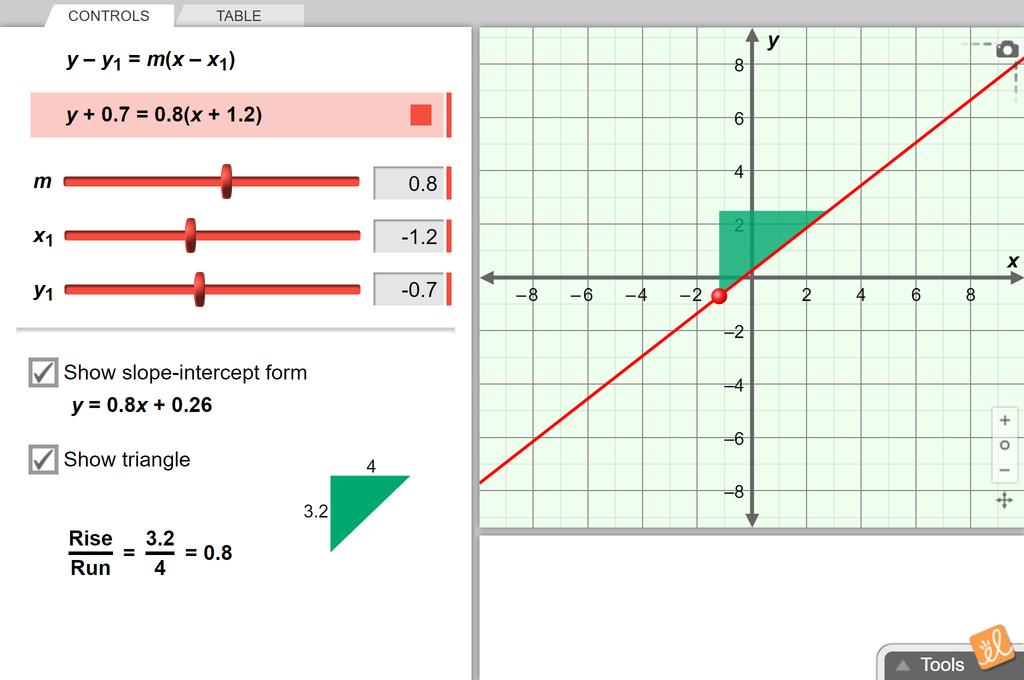
Point-Slope Form of a Line
Compare the point-slope form of a linear equation to its graph. Vary the coefficients and explore how the graph changes in response. 5 Minute Preview

Points, Lines, and Equations
Compare the graph of a linear function to its rule and to a table of its values. Change the function by dragging two points on the line. Examine how the rule and table change. 5 Minute Preview
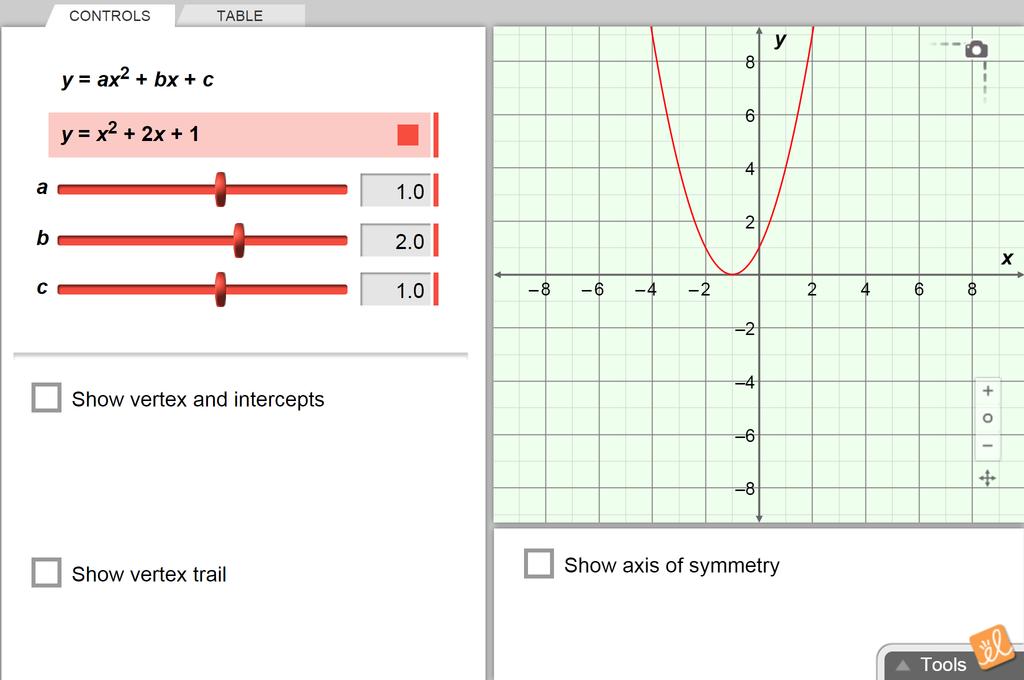
Quadratics in Polynomial Form
Compare the graph of a quadratic to its equation in polynomial form. Vary the coefficients of the equation and explore how the graph changes in response. 5 Minute Preview

Quadratics in Vertex Form
Compare the graph of a quadratic to its equation in vertex form. Vary the terms of the equation and explore how the graph changes in response. 5 Minute Preview
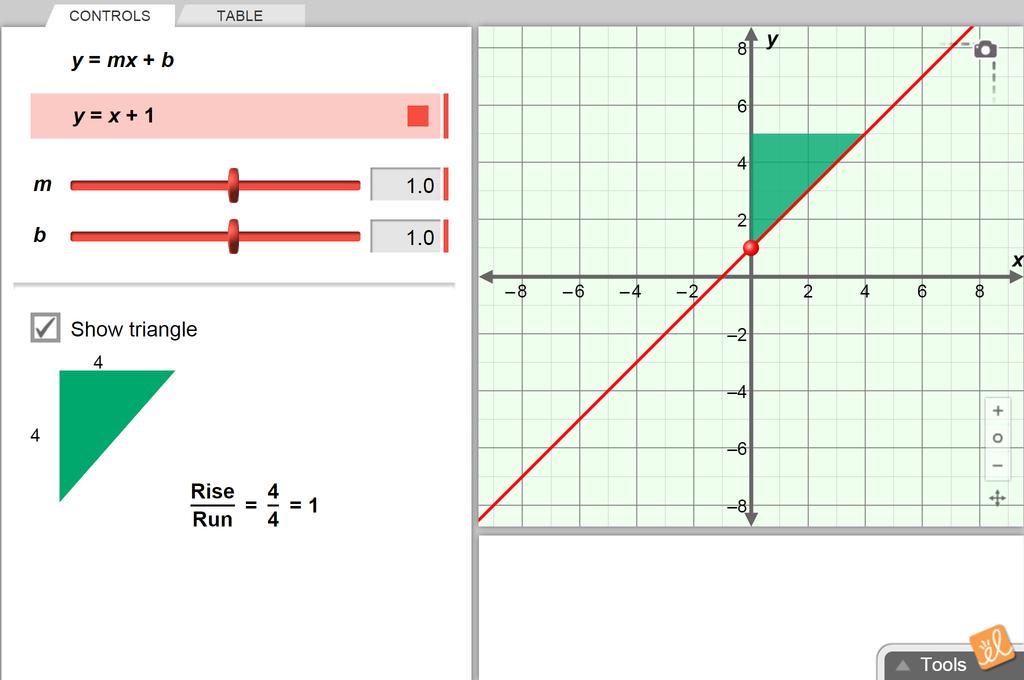
Slope-Intercept Form of a Line
Compare the slope-intercept form of a linear equation to its graph. Vary the coefficients and explore how the graph changes in response. 5 Minute Preview

Solving Equations on the Number Line
Solve an equation involving decimals using dynamic arrows on a number line. 5 Minute Preview
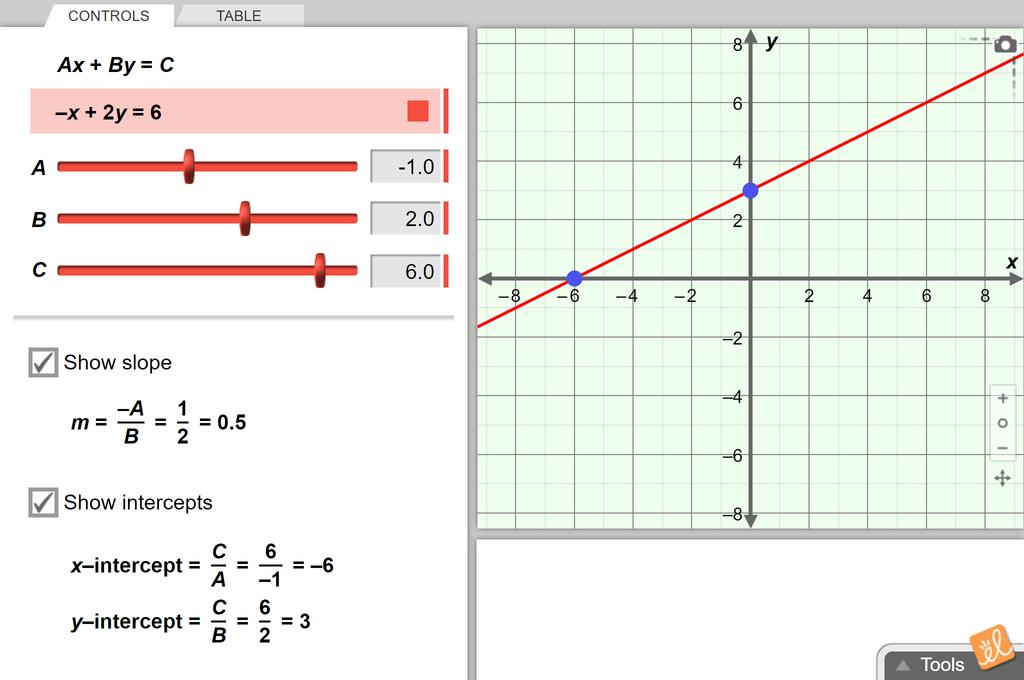
Standard Form of a Line
Compare the standard form of a linear equation to its graph. Vary the coefficients and explore how the graph changes in response. 5 Minute Preview

Using Algebraic Equations
Translate equations into English sentences and translate English sentences into equations. Read the equation or sentence and select word tiles or symbol tiles to form the corresponding sentence or equation. 5 Minute Preview
A-CED.3: : Represent constraints by equations or inequalities, and by systems of equations and/or inequalities, and interpret solutions as viable or non-viable options in a modeling context.

Linear Inequalities in Two Variables
Find the solution set to a linear inequality in two variables using the graph of the linear inequality. Vary the terms of the inequality and vary the inequality symbol. Examine how the boundary line and shaded region change in response. 5 Minute Preview
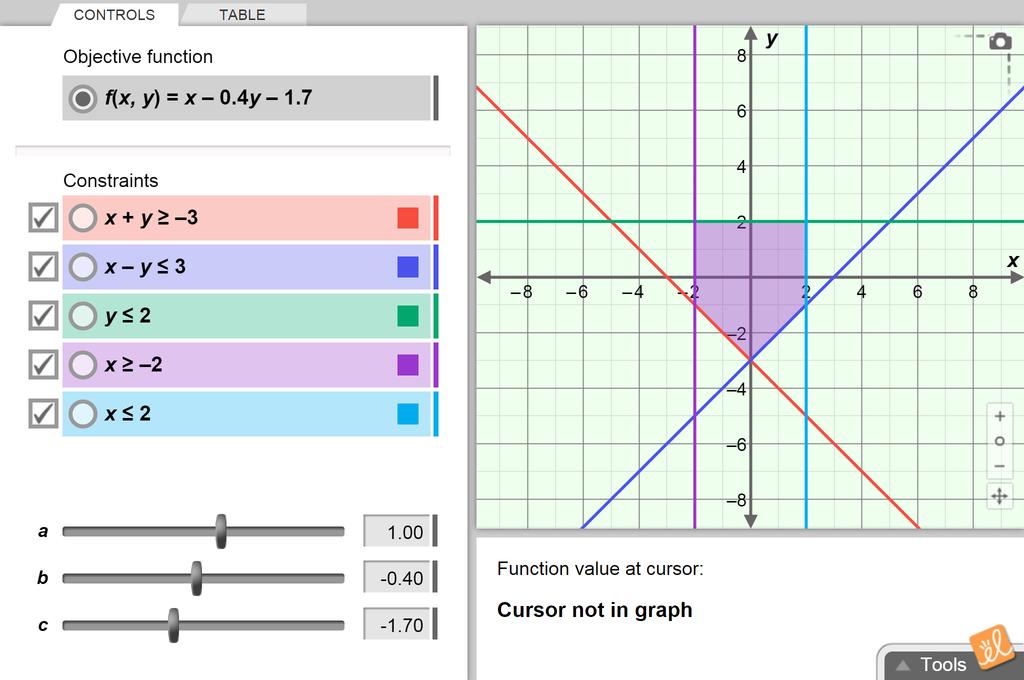
Linear Programming
Use the graph of the feasible region to find the maximum or minimum value of the objective function. Vary the coefficients of the objective function and vary the constraints. Explore how the graph of the feasible region changes in response. 5 Minute Preview

Solving Linear Systems (Standard Form)
Solve systems of linear equations, written in standard form. Explore what it means to solve systems algebraically (with substitution or elimination) and graphically. Also, use a draggable green point to see what it means when (x, y) values are solutions of an equation, or of a system of equations. 5 Minute Preview

Systems of Linear Inequalities (Slope-intercept form)
Compare a system of linear inequalities to its graph. Vary the coefficients and inequality symbols in the system and explore how the boundary lines, shaded regions, and the intersection of the shaded regions change in response. 5 Minute Preview
A-REI: : Reasoning with Equations and Inequalities
2.4.1: : Understand solving equations as a process of reasoning and explain the reasoning
A-REI.1: : Explain each step in solving a simple equation as following from the equality of numbers asserted at the previous step, starting from the assumption that the original equation has a solution. Construct a viable argument to justify a solution method.

Modeling One-Step Equations
Solve a linear equation using a tile model. Use feedback to diagnose incorrect steps. 5 Minute Preview

Modeling and Solving Two-Step Equations
Solve a two-step equation using a cup-and-counter model. Use step-by-step feedback to diagnose and correct incorrect steps. 5 Minute Preview

Solving Algebraic Equations II
Is solving equations tricky? If you know how to isolate a variable, you're halfway there. The other half? Don't do anything to upset the balance of an equation. Join our plucky variable friend as he encounters algebraic equations and a (sometimes grumpy) equal sign. With a little practice, you'll find that solving equations isn't tricky at all. 5 Minute Preview

Solving Equations on the Number Line
Solve an equation involving decimals using dynamic arrows on a number line. 5 Minute Preview

Solving Formulas for any Variable
Choose the correct steps to solve a formula for a given variable. Use the feedback to diagnose incorrect steps. 5 Minute Preview

Solving Two-Step Equations
Choose the correct steps to solve a two-step equation. Use the feedback to diagnose incorrect steps. 5 Minute Preview
A-REI.2: : Solve simple rational and radical equations in one variable, and give examples showing how extraneous solutions may arise.

Radical Functions
Compare the graph of a radical function to its equation. Vary the terms of the equation. Explore how the graph is translated and stretched by the changes to the equation. 5 Minute Preview
2.4.2: : Solve equations and inequalities in one variable
A-REI.4: : Solve quadratic equations in one variable.
A-REI.4b: : Solve quadratic equations by inspection (e.g., for x² = 49), taking square roots, completing the square, the quadratic formula and factoring, as appropriate to the initial form of the equation. Recognize when the quadratic formula gives complex solutions.

Factoring Special Products
Choose the correct steps to factor a polynomial involving perfect-square binomials, differences of squares, or constant factors. Use the feedback to diagnose incorrect steps. 5 Minute Preview

Modeling the Factorization of ax2+bx+c
Factor a polynomial with a leading coefficient greater than 1 using an area model. Use step-by-step feedback to diagnose any mistakes. 5 Minute Preview

Modeling the Factorization of x2+bx+c
Factor a polynomial with a leading coefficient equal to 1 using an area model. Use step-by-step feedback to diagnose any mistakes. 5 Minute Preview

Points in the Complex Plane
Identify the imaginary and real coordinates of a point in the complex plane. Drag the point in the plane and investigate how the coordinates change in response. 5 Minute Preview

Roots of a Quadratic
Find the root of a quadratic using its graph or the quadratic formula. Explore the graph of the roots and the point of symmetry in the complex plane. Compare the axis of symmetry and graph of the quadratic in the real plane. 5 Minute Preview
2.4.3: : Solve systems of equations
A-REI.6: : Solve systems of linear equations exactly and approximately (e.g., with graphs), focusing on pairs of linear equations in two variables.

Cat and Mouse (Modeling with Linear Systems)
Experiment with a system of two lines representing a cat-and-mouse chase. Adjust the speeds of the cat and mouse and the head start of the mouse, and immediately see the effects on the graph and on the chase. Connect real-world meaning to slope, y-intercept, and the intersection of lines. 5 Minute Preview
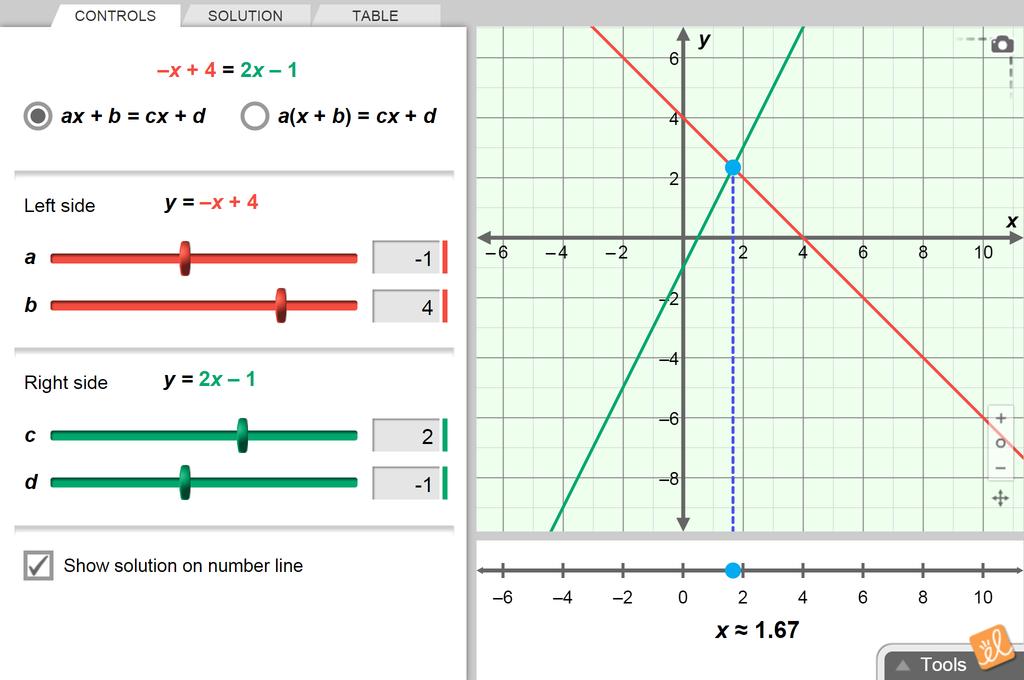
Solving Equations by Graphing Each Side
Solve an equation by graphing each side and finding the intersection of the lines. Vary the coefficients in the equation and explore how the graph changes in response. 5 Minute Preview
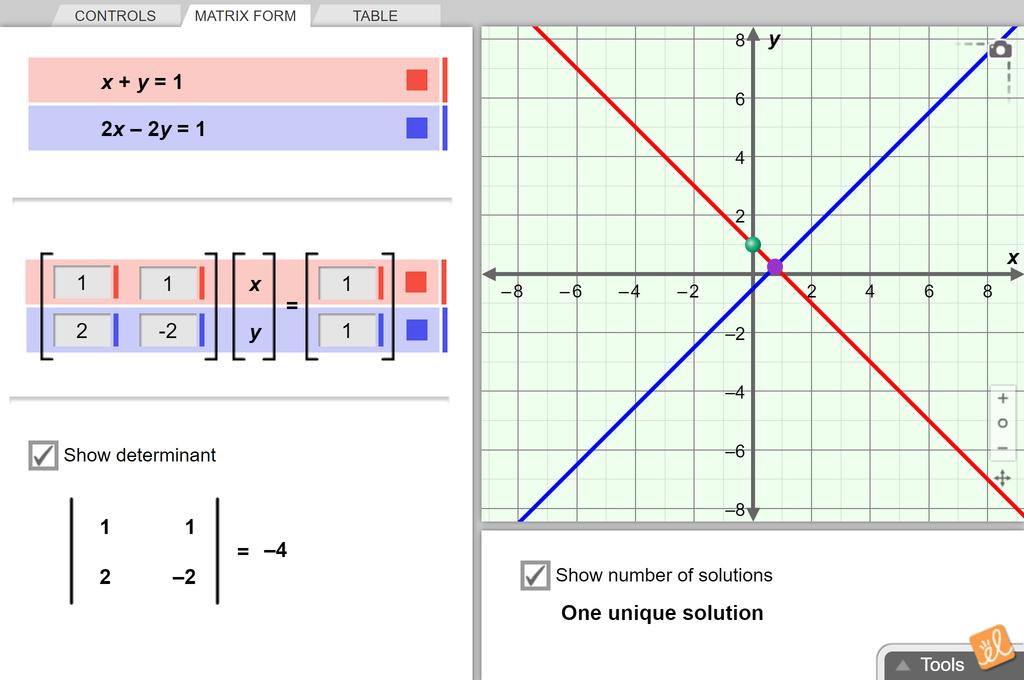
Solving Linear Systems (Matrices and Special Solutions)
Explore systems of linear equations, and how many solutions a system can have. Express systems in matrix form. See how the determinant of the coefficient matrix reveals how many solutions a system of equations has. Also, use a draggable green point to see what it means for an (x, y) point to be a solution of an equation, or of a system of equations. 5 Minute Preview
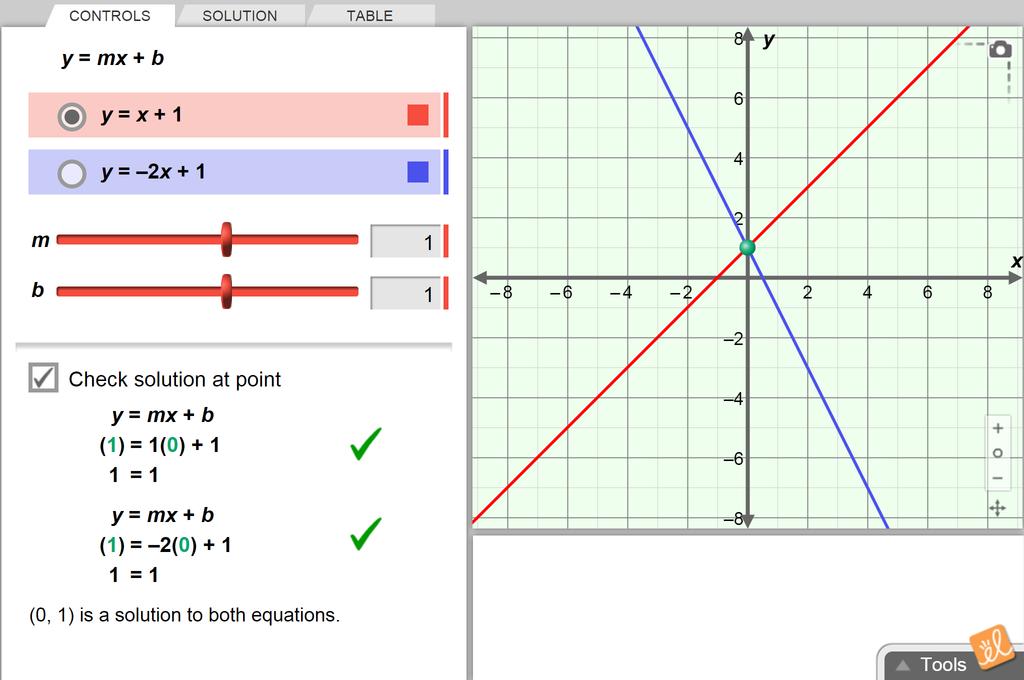
Solving Linear Systems (Slope-Intercept Form)
Solve systems of linear equations, given in slope-intercept form, both graphically and algebraically. Use a draggable green point to examine what it means for an

Solving Linear Systems (Standard Form)
Solve systems of linear equations, written in standard form. Explore what it means to solve systems algebraically (with substitution or elimination) and graphically. Also, use a draggable green point to see what it means when (x, y) values are solutions of an equation, or of a system of equations. 5 Minute Preview
2.4.4: : Represent and solve equations and inequalities graphically
A-REI.11: : Explain why the x-coordinates of the points where the graphs of the equations y = f(x) and y = g(x) intersect are the solutions of the equation f(x) = g(x); find the solutions approximately, e.g., using technology to graph the functions, make tables of values, or find successive approximations. Include cases where f(x) and/or g(x) are linear, polynomial, rational, absolute value, exponential, and logarithmic functions.

Cat and Mouse (Modeling with Linear Systems)
Experiment with a system of two lines representing a cat-and-mouse chase. Adjust the speeds of the cat and mouse and the head start of the mouse, and immediately see the effects on the graph and on the chase. Connect real-world meaning to slope, y-intercept, and the intersection of lines. 5 Minute Preview

Point-Slope Form of a Line
Compare the point-slope form of a linear equation to its graph. Vary the coefficients and explore how the graph changes in response. 5 Minute Preview

Solving Equations by Graphing Each Side
Solve an equation by graphing each side and finding the intersection of the lines. Vary the coefficients in the equation and explore how the graph changes in response. 5 Minute Preview

Solving Linear Systems (Matrices and Special Solutions)
Explore systems of linear equations, and how many solutions a system can have. Express systems in matrix form. See how the determinant of the coefficient matrix reveals how many solutions a system of equations has. Also, use a draggable green point to see what it means for an (x, y) point to be a solution of an equation, or of a system of equations. 5 Minute Preview

Solving Linear Systems (Slope-Intercept Form)
Solve systems of linear equations, given in slope-intercept form, both graphically and algebraically. Use a draggable green point to examine what it means for an

Standard Form of a Line
Compare the standard form of a linear equation to its graph. Vary the coefficients and explore how the graph changes in response. 5 Minute Preview
F: : Functions
F-IF: : Interpreting Functions
3.1.1: : Understand the concept of a function and use function notation
F-IF.3: : Recognize that sequences are functions, sometimes defined recursively, whose domain is a subset of the integers.

Arithmetic Sequences
Find the value of individual terms in arithmetic sequences using graphs of the sequences and direct computation. Vary the common difference and examine how the sequences change in response. 5 Minute Preview

Geometric Sequences
Explore geometric sequences by varying the initial term and the common ratio and examining the graph. Compute specific terms in the sequence using the explicit and recursive formulas. 5 Minute Preview
3.1.2: : Interpret functions that arise in applications in terms of the context
F-IF.4: : For a function that models a relationship between two quantities, interpret key features of graphs and tables in terms of the quantities, and sketch graphs showing key features given a verbal description of the relationship.
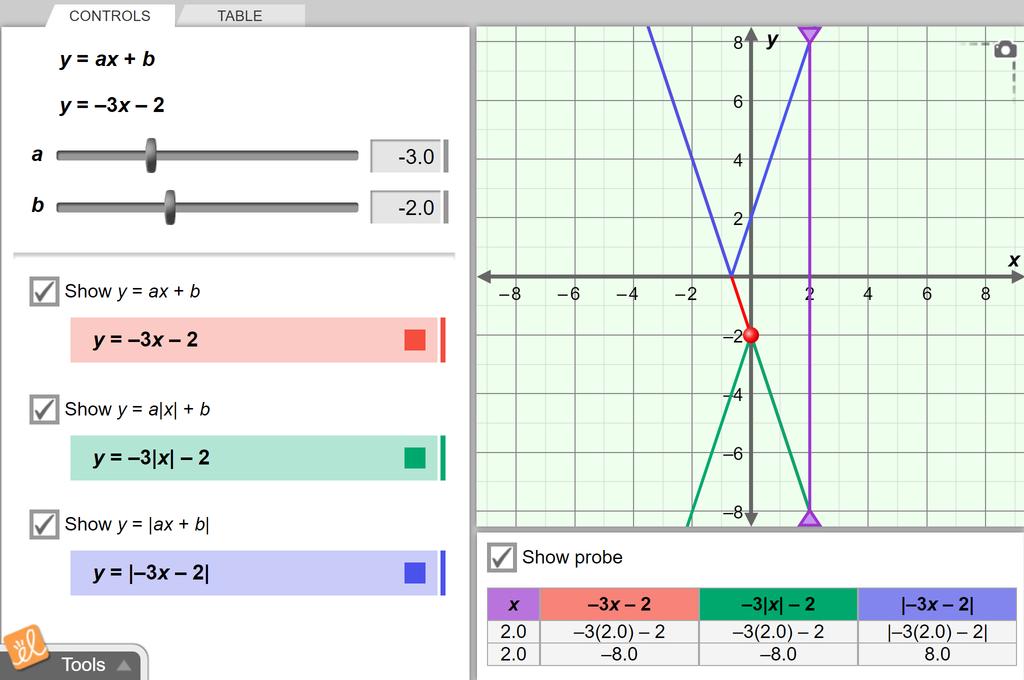
Absolute Value with Linear Functions
Compare the graph of a linear function, the graph of an absolute-value function, and the graphs of their translations. Vary the coefficients and constants in the functions and investigate how the graphs change in response. 5 Minute Preview

Exponential Functions
Explore the graph of an exponential function. Vary the coefficient and base of the function and investigate the changes to the graph of the function. 5 Minute Preview

Function Machines 3 (Functions and Problem Solving)
Drop a number into a function machine, and see what number comes out! You can use one of the six pre-set function machines, or program your own function rule into one of the blank machines. Stack up to three function machines together. Input and output can be recorded in a table and on a graph. 5 Minute Preview
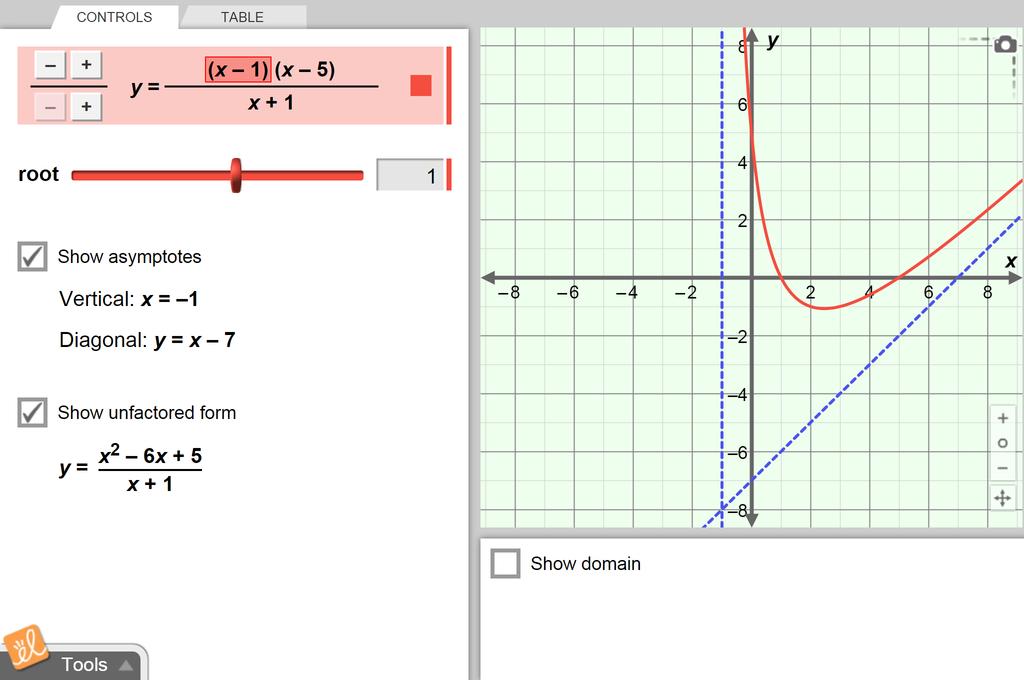
General Form of a Rational Function
Compare the equation of a rational function to its graph. Multiply or divide the numerator and denominator by linear factors and explore how the graph changes in response. 5 Minute Preview

Graphs of Polynomial Functions
Study the graphs of polynomials up to the fourth degree. Vary the coefficients of the equation and investigate how the graph changes in response. Explore things like intercepts, end behavior, and even near-zero behavior. 5 Minute Preview
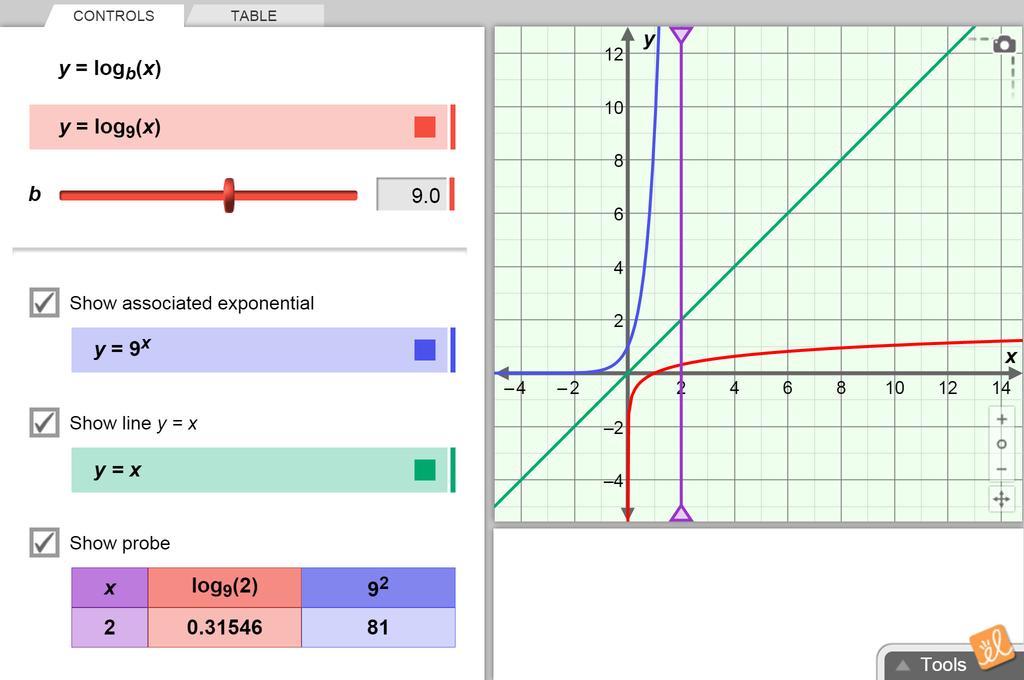
Logarithmic Functions
Compare the equation of a logarithmic function to its graph. Change the base of the logarithmic function and examine how the graph changes in response. Use the line y = x to compare the associated exponential function. 5 Minute Preview

Points, Lines, and Equations
Compare the graph of a linear function to its rule and to a table of its values. Change the function by dragging two points on the line. Examine how the rule and table change. 5 Minute Preview

Quadratics in Factored Form
Investigate the factors of a quadratic through its graph and through its equation. Vary the roots of the quadratic and examine how the graph and the equation change in response. 5 Minute Preview

Quadratics in Polynomial Form
Compare the graph of a quadratic to its equation in polynomial form. Vary the coefficients of the equation and explore how the graph changes in response. 5 Minute Preview

Quadratics in Vertex Form
Compare the graph of a quadratic to its equation in vertex form. Vary the terms of the equation and explore how the graph changes in response. 5 Minute Preview

Radical Functions
Compare the graph of a radical function to its equation. Vary the terms of the equation. Explore how the graph is translated and stretched by the changes to the equation. 5 Minute Preview
F-IF.6: : Calculate and interpret the average rate of change of a function (presented symbolically or as a table) over a specified interval. Estimate the rate of change from a graph.

Cat and Mouse (Modeling with Linear Systems)
Experiment with a system of two lines representing a cat-and-mouse chase. Adjust the speeds of the cat and mouse and the head start of the mouse, and immediately see the effects on the graph and on the chase. Connect real-world meaning to slope, y-intercept, and the intersection of lines. 5 Minute Preview

Slope
Explore the slope of a line, and learn how to calculate slope. Adjust the line by moving points that are on the line, and see how its slope changes. 5 Minute Preview
3.1.3: : Analyze functions using different representations
F-IF.7: : Graph functions expressed symbolically and show key features of the graph, by hand in simple cases and using technology for more complicated cases.
F-IF.7c: : Graph polynomial functions, identifying zeros when suitable factorizations are available, and showing end behavior.

Graphs of Polynomial Functions
Study the graphs of polynomials up to the fourth degree. Vary the coefficients of the equation and investigate how the graph changes in response. Explore things like intercepts, end behavior, and even near-zero behavior. 5 Minute Preview

Polynomials and Linear Factors
Create a polynomial as a product of linear factors. Vary the values in the linear factors to see how their connection to the roots of the function. 5 Minute Preview

Quadratics in Factored Form
Investigate the factors of a quadratic through its graph and through its equation. Vary the roots of the quadratic and examine how the graph and the equation change in response. 5 Minute Preview

Roots of a Quadratic
Find the root of a quadratic using its graph or the quadratic formula. Explore the graph of the roots and the point of symmetry in the complex plane. Compare the axis of symmetry and graph of the quadratic in the real plane. 5 Minute Preview
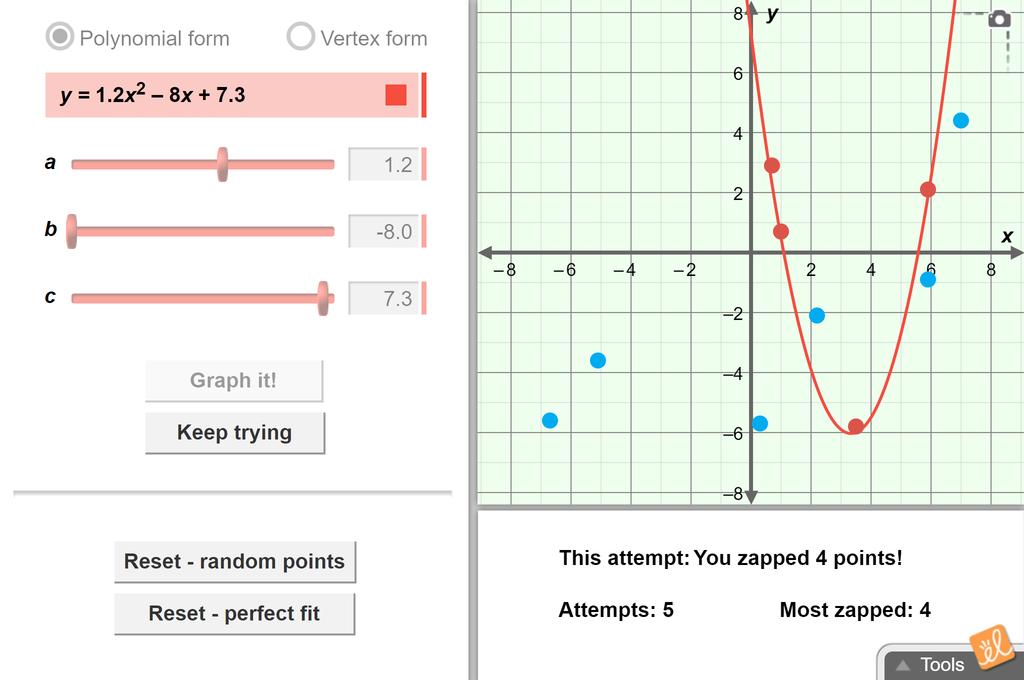
Zap It! Game
Adjust the values in a quadratic function, in vertex form or in polynomial form, to "zap" as many data points as possible. 5 Minute Preview
F-IF.7e: : Graph exponential and logarithmic functions, showing intercepts and end behavior, and trigonometric functions, showing period, midline, and amplitude.
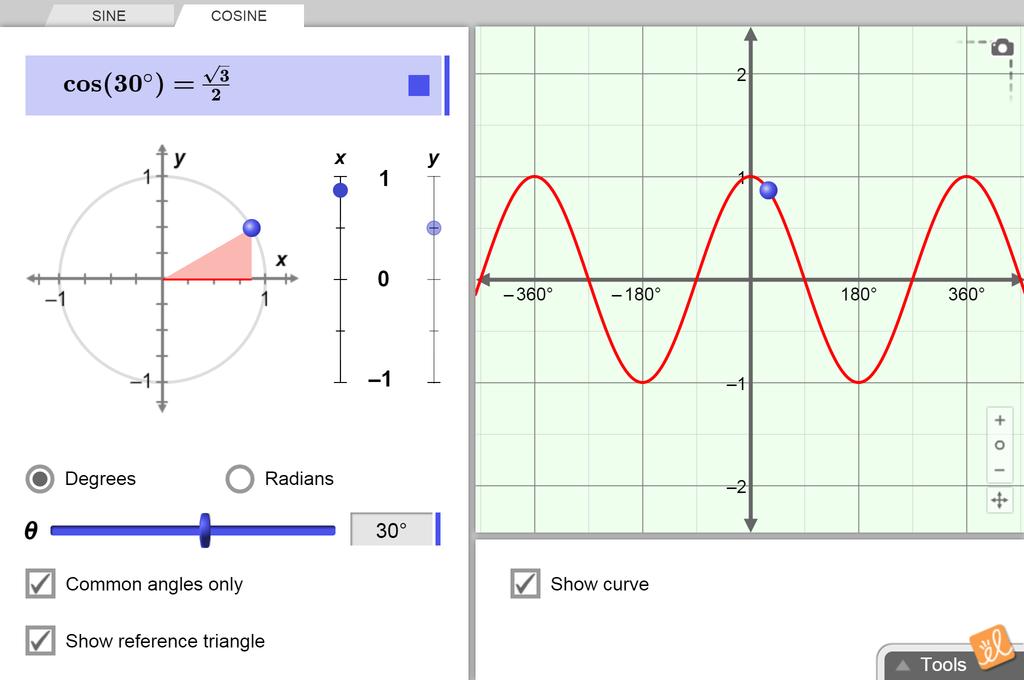
Cosine Function
Compare the graph of the cosine function with the graph of the angle on the unit circle. Drag a point along the cosine curve and see the corresponding angle on the unit circle. 5 Minute Preview

Exponential Functions
Explore the graph of an exponential function. Vary the coefficient and base of the function and investigate the changes to the graph of the function. 5 Minute Preview
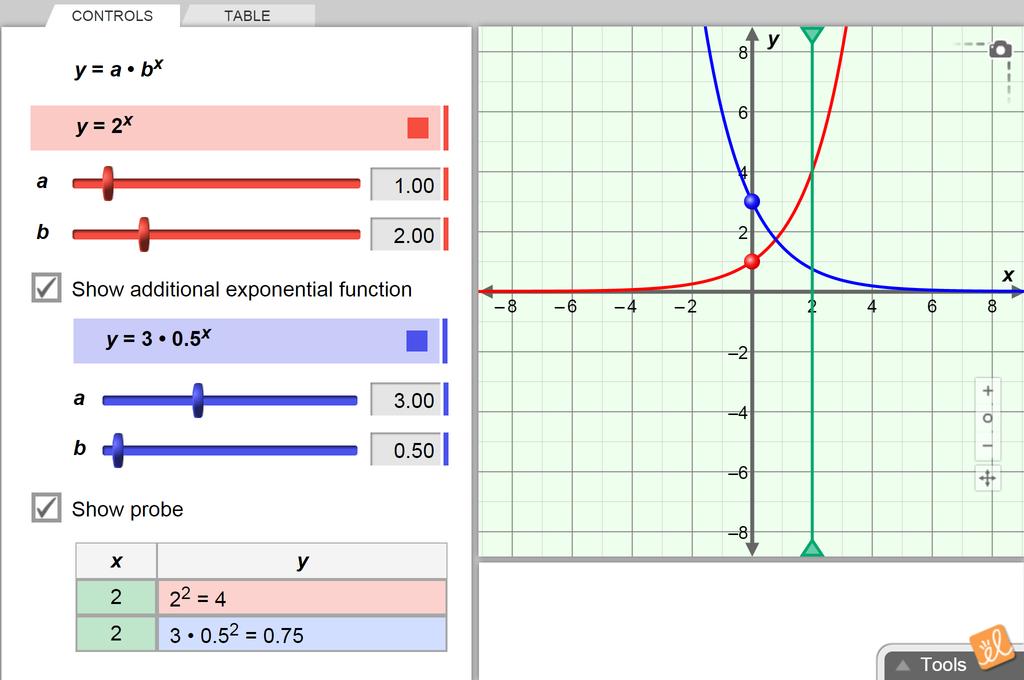
Introduction to Exponential Functions
Explore the graph of the exponential function. Vary the initial amount and base of the function. Investigate the changes to the graph. 5 Minute Preview

Logarithmic Functions
Compare the equation of a logarithmic function to its graph. Change the base of the logarithmic function and examine how the graph changes in response. Use the line y = x to compare the associated exponential function. 5 Minute Preview
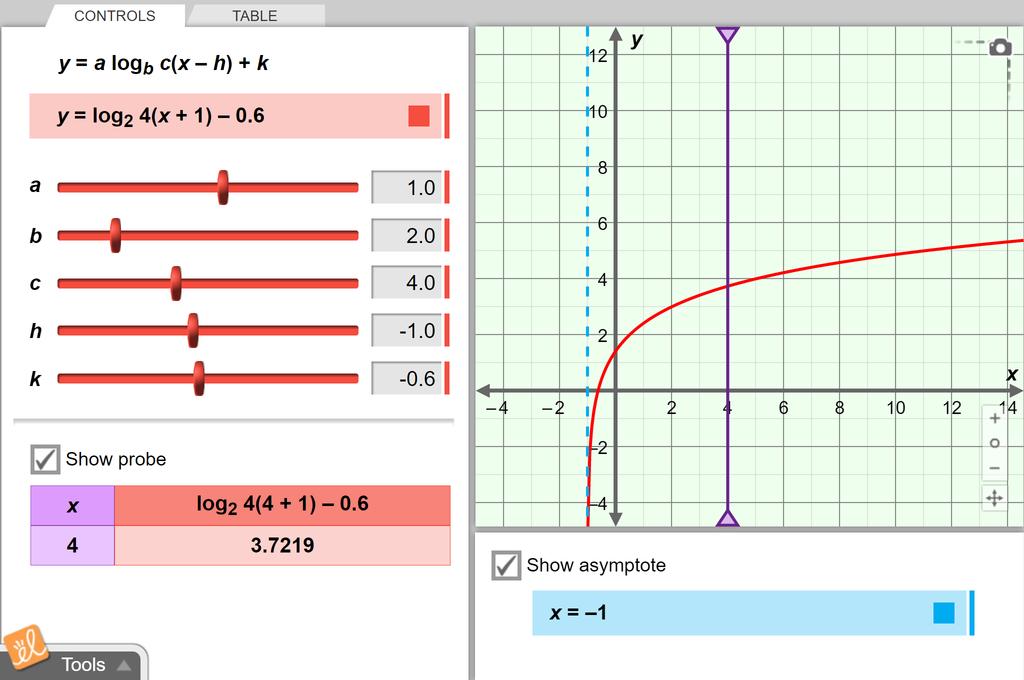
Logarithmic Functions: Translating and Scaling
Vary the values in the equation of a logarithmic function and examine how the graph is translated or scaled. Connect these transformations with the domain of the function, and the asymptote in the graph. 5 Minute Preview
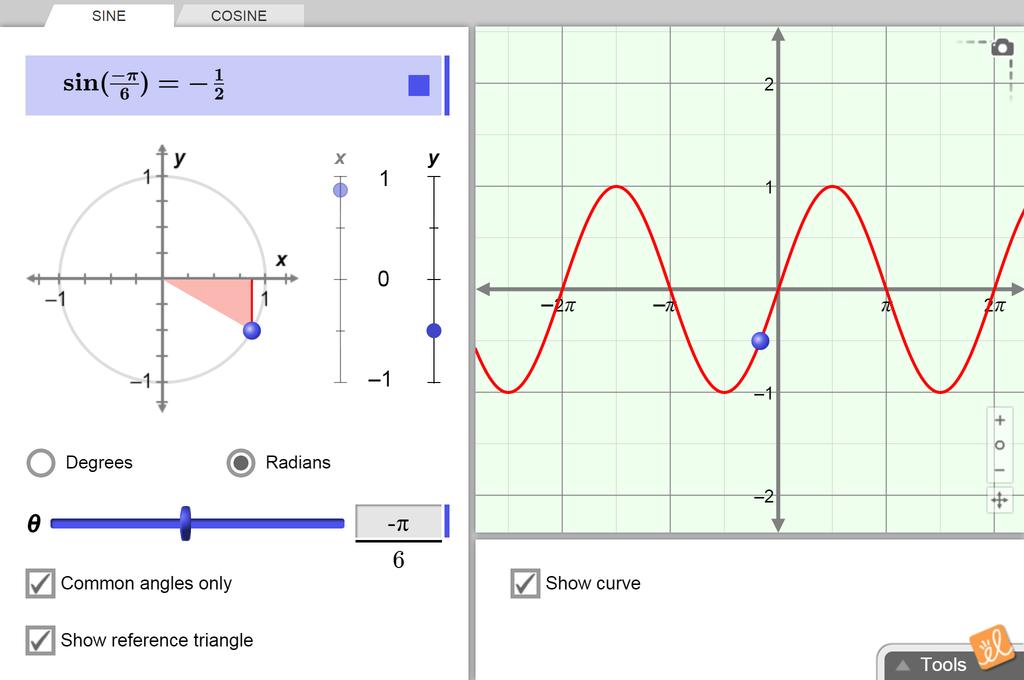
Sine Function
Compare the graph of the sine function with the graph of the angle on the unit circle. Drag a point along the sine curve and see the corresponding angle on the unit circle. 5 Minute Preview

Tangent Function
Compare the graph of the tangent function with the graph of the angle on the unit circle. Drag a point along the tangent curve and see the corresponding angle on the unit circle. 5 Minute Preview
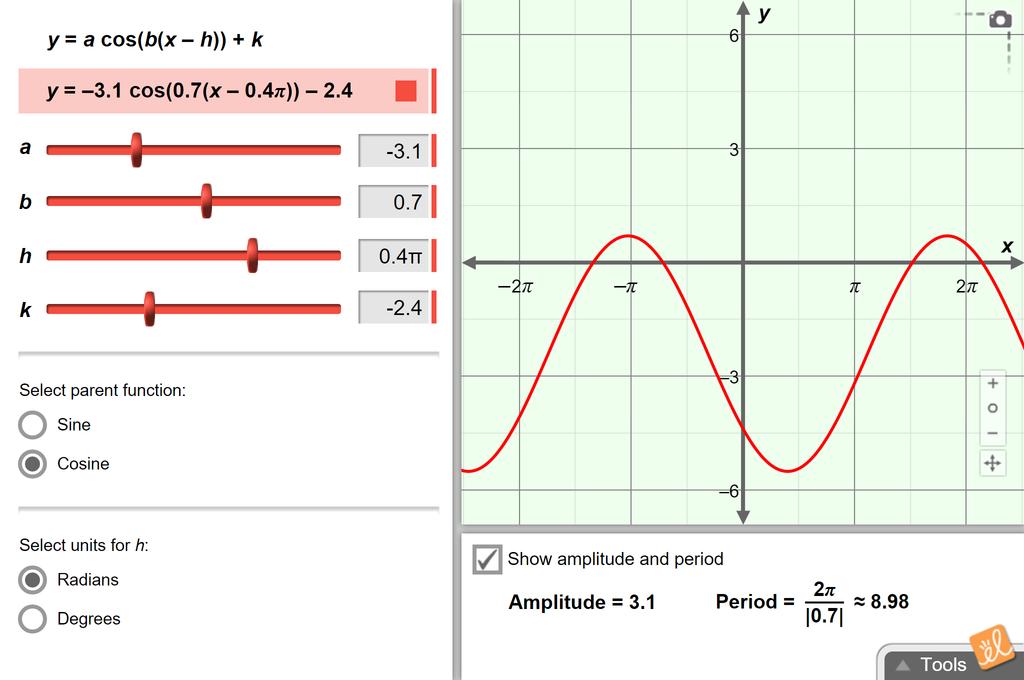
Translating and Scaling Sine and Cosine Functions
Experiment with the graph of a sine or cosine function. Explore how changing the values in the equation can translate or scale the graph of the function. 5 Minute Preview
F-IF.8: : Write a function defined by an expression in different but equivalent forms to reveal and explain different properties of the function.
F-IF.8b: : Use the properties of exponents to interpret expressions for exponential functions.

Compound Interest
Explore compound interest in-depth, from compounded annually to compounded continuously. In addition, compare the END POINTS graph, with dots that fit an exponential curve, to the ALL TIME graph, which has a more step-like appearance. 5 Minute Preview

Exponential Functions
Explore the graph of an exponential function. Vary the coefficient and base of the function and investigate the changes to the graph of the function. 5 Minute Preview
F-IF.9: : Compare properties of two functions each represented in a different way (algebraically, graphically, numerically in tables, or by verbal descriptions).

General Form of a Rational Function
Compare the equation of a rational function to its graph. Multiply or divide the numerator and denominator by linear factors and explore how the graph changes in response. 5 Minute Preview

Graphs of Polynomial Functions
Study the graphs of polynomials up to the fourth degree. Vary the coefficients of the equation and investigate how the graph changes in response. Explore things like intercepts, end behavior, and even near-zero behavior. 5 Minute Preview

Linear Functions
Determine if a relation is a function from the mapping diagram, ordered pairs, or graph. Use the graph to determine if it is linear. 5 Minute Preview

Logarithmic Functions
Compare the equation of a logarithmic function to its graph. Change the base of the logarithmic function and examine how the graph changes in response. Use the line y = x to compare the associated exponential function. 5 Minute Preview

Quadratics in Polynomial Form
Compare the graph of a quadratic to its equation in polynomial form. Vary the coefficients of the equation and explore how the graph changes in response. 5 Minute Preview

Quadratics in Vertex Form
Compare the graph of a quadratic to its equation in vertex form. Vary the terms of the equation and explore how the graph changes in response. 5 Minute Preview
F-BF: : Building Functions
3.2.1: : Build a function that models a relationship between two quantities
F-BF.1: : Write a function that describes a relationship between two quantities.
F-BF.1a: : Determine an explicit expression, a recursive process, or steps for calculation from a context.

Arithmetic Sequences
Find the value of individual terms in arithmetic sequences using graphs of the sequences and direct computation. Vary the common difference and examine how the sequences change in response. 5 Minute Preview

Arithmetic and Geometric Sequences
Find the value of individual terms in an arithmetic or geometric sequence using graphs of the sequence and direct computation. Vary the common difference and common ratio and examine how the sequence changes in response. 5 Minute Preview

Geometric Sequences
Explore geometric sequences by varying the initial term and the common ratio and examining the graph. Compute specific terms in the sequence using the explicit and recursive formulas. 5 Minute Preview
F-BF.1b: : Combine standard function types using arithmetic operations.
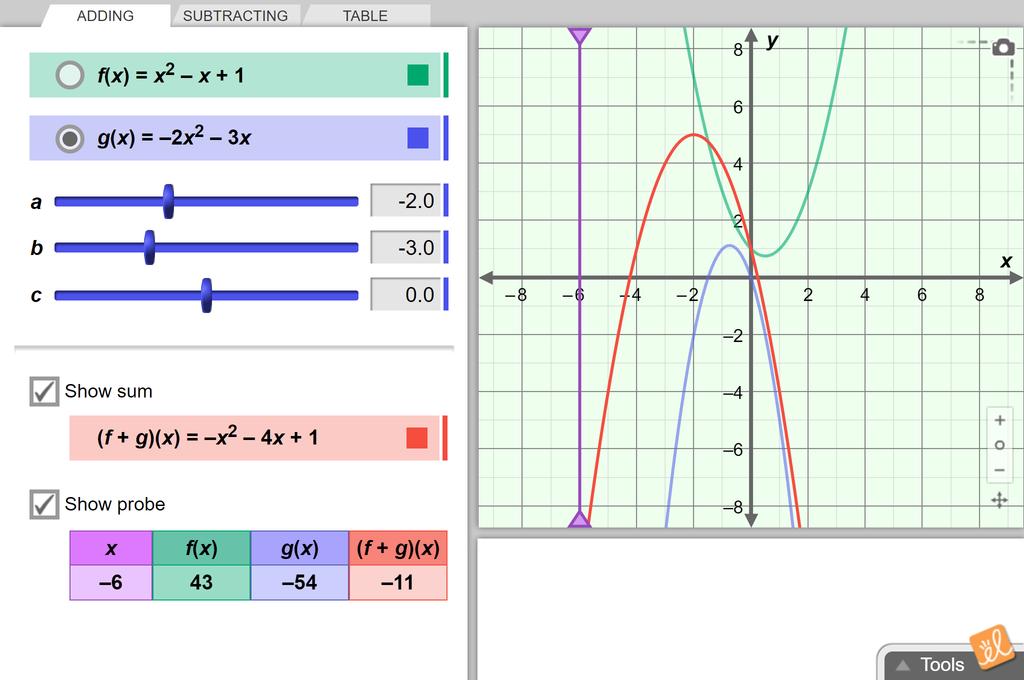
Addition and Subtraction of Functions
Explore the graphs of two polynomials and the graph of their sum or difference. Vary the coefficients in the polynomials and investigate how the graphs change in response. 5 Minute Preview
F-BF.2: : Write arithmetic and geometric sequences both recursively and with an explicit formula, use them to model situations, and translate between the two forms.

Arithmetic Sequences
Find the value of individual terms in arithmetic sequences using graphs of the sequences and direct computation. Vary the common difference and examine how the sequences change in response. 5 Minute Preview

Arithmetic and Geometric Sequences
Find the value of individual terms in an arithmetic or geometric sequence using graphs of the sequence and direct computation. Vary the common difference and common ratio and examine how the sequence changes in response. 5 Minute Preview

Geometric Sequences
Explore geometric sequences by varying the initial term and the common ratio and examining the graph. Compute specific terms in the sequence using the explicit and recursive formulas. 5 Minute Preview
3.2.2: : Build new functions from existing functions
F-BF.3: : Identify the effect on the graph of replacing f(x) by f(x) + k, k f(x), f(kx), and f(x + k) for specific values of k (both positive and negative); find the value of k given the graphs. Experiment with cases and illustrate an explanation of the effects on the graph using technology.

Absolute Value with Linear Functions
Compare the graph of a linear function, the graph of an absolute-value function, and the graphs of their translations. Vary the coefficients and constants in the functions and investigate how the graphs change in response. 5 Minute Preview

Exponential Functions
Explore the graph of an exponential function. Vary the coefficient and base of the function and investigate the changes to the graph of the function. 5 Minute Preview

Introduction to Exponential Functions
Explore the graph of the exponential function. Vary the initial amount and base of the function. Investigate the changes to the graph. 5 Minute Preview

Logarithmic Functions
Compare the equation of a logarithmic function to its graph. Change the base of the logarithmic function and examine how the graph changes in response. Use the line y = x to compare the associated exponential function. 5 Minute Preview

Logarithmic Functions: Translating and Scaling
Vary the values in the equation of a logarithmic function and examine how the graph is translated or scaled. Connect these transformations with the domain of the function, and the asymptote in the graph. 5 Minute Preview

Quadratics in Vertex Form
Compare the graph of a quadratic to its equation in vertex form. Vary the terms of the equation and explore how the graph changes in response. 5 Minute Preview

Radical Functions
Compare the graph of a radical function to its equation. Vary the terms of the equation. Explore how the graph is translated and stretched by the changes to the equation. 5 Minute Preview
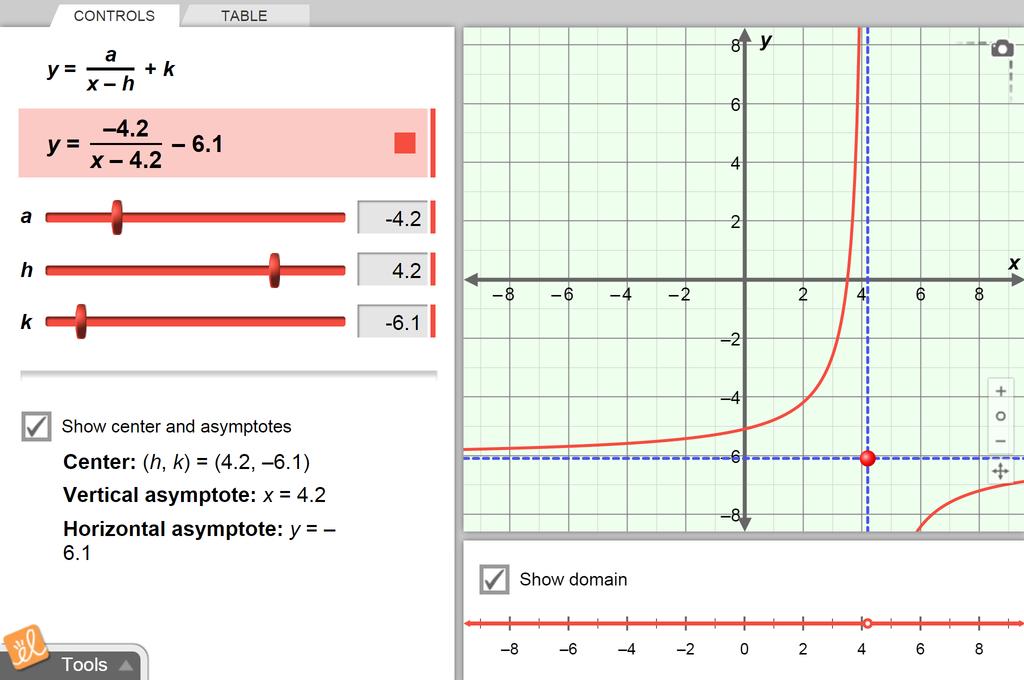
Rational Functions
Compare the graph of a rational function to its equation. Vary the terms of the equation and explore how the graph is translated and stretched as a result. Examine the domain on a number line and compare it to the graph of the equation. 5 Minute Preview
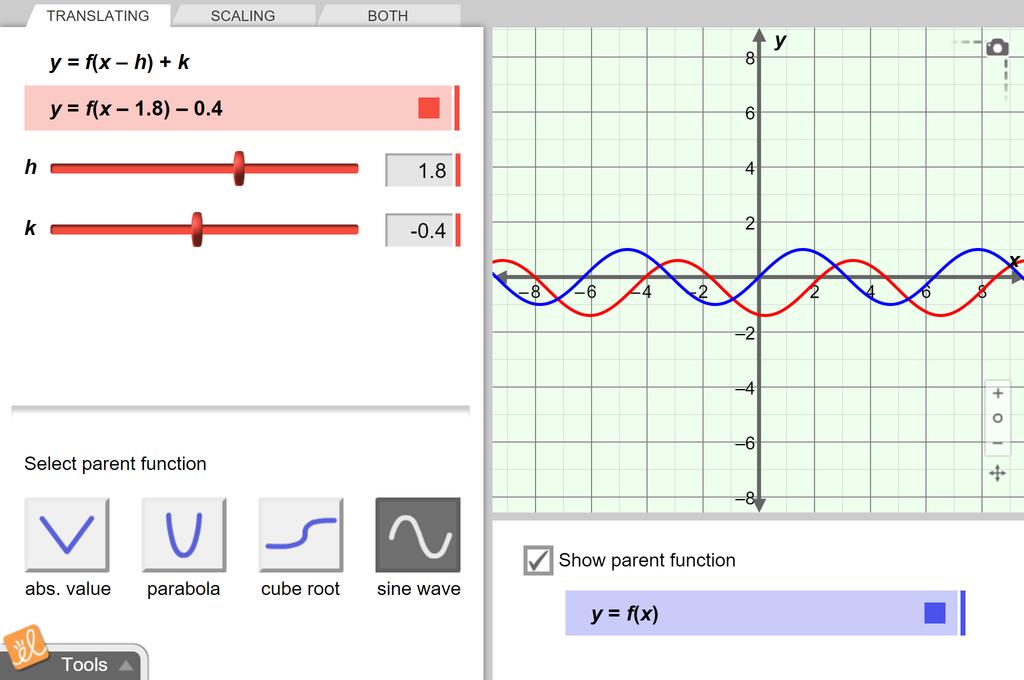
Translating and Scaling Functions
Vary the coefficients in the equation of a function and examine how the graph of the function is translated or scaled. Select different functions to translate and scale, and determine what they have in common. 5 Minute Preview

Translating and Scaling Sine and Cosine Functions
Experiment with the graph of a sine or cosine function. Explore how changing the values in the equation can translate or scale the graph of the function. 5 Minute Preview

Translations
Translate a figure horizontally and vertically in the plane and examine the matrix representation of the translation. 5 Minute Preview

Zap It! Game
Adjust the values in a quadratic function, in vertex form or in polynomial form, to "zap" as many data points as possible. 5 Minute Preview
F-LE: : Linear, Quadratic, and Exponential Models
3.3.1: : Construct and compare linear, quadratic, and exponential models and solve problems
F-LE.2: : Construct linear and exponential functions, including arithmetic and geometric sequences, given a graph, a description of a relationship, or two input-output pairs (include reading these from a table).

Absolute Value with Linear Functions
Compare the graph of a linear function, the graph of an absolute-value function, and the graphs of their translations. Vary the coefficients and constants in the functions and investigate how the graphs change in response. 5 Minute Preview

Arithmetic Sequences
Find the value of individual terms in arithmetic sequences using graphs of the sequences and direct computation. Vary the common difference and examine how the sequences change in response. 5 Minute Preview

Arithmetic and Geometric Sequences
Find the value of individual terms in an arithmetic or geometric sequence using graphs of the sequence and direct computation. Vary the common difference and common ratio and examine how the sequence changes in response. 5 Minute Preview

Compound Interest
Explore compound interest in-depth, from compounded annually to compounded continuously. In addition, compare the END POINTS graph, with dots that fit an exponential curve, to the ALL TIME graph, which has a more step-like appearance. 5 Minute Preview

Exponential Functions
Explore the graph of an exponential function. Vary the coefficient and base of the function and investigate the changes to the graph of the function. 5 Minute Preview

Function Machines 1 (Functions and Tables)
Drop a number into a function machine, and see what number comes out! You can use one of the six pre-set function machines, or program your own function rule into one of the blank machines. Stack up to three function machines together. Input and output can be recorded in a table and on a graph. 5 Minute Preview

Function Machines 2 (Functions, Tables, and Graphs)
Drop a number into a function machine, and see what number comes out! You can use one of the six pre-set function machines, or program your own function rule into one of the blank machines. Stack up to three function machines together. Input and output can be recorded in a table and on a graph. 5 Minute Preview

Function Machines 3 (Functions and Problem Solving)
Drop a number into a function machine, and see what number comes out! You can use one of the six pre-set function machines, or program your own function rule into one of the blank machines. Stack up to three function machines together. Input and output can be recorded in a table and on a graph. 5 Minute Preview

Geometric Sequences
Explore geometric sequences by varying the initial term and the common ratio and examining the graph. Compute specific terms in the sequence using the explicit and recursive formulas. 5 Minute Preview

Introduction to Exponential Functions
Explore the graph of the exponential function. Vary the initial amount and base of the function. Investigate the changes to the graph. 5 Minute Preview

Linear Functions
Determine if a relation is a function from the mapping diagram, ordered pairs, or graph. Use the graph to determine if it is linear. 5 Minute Preview

Logarithmic Functions
Compare the equation of a logarithmic function to its graph. Change the base of the logarithmic function and examine how the graph changes in response. Use the line y = x to compare the associated exponential function. 5 Minute Preview

Point-Slope Form of a Line
Compare the point-slope form of a linear equation to its graph. Vary the coefficients and explore how the graph changes in response. 5 Minute Preview

Points, Lines, and Equations
Compare the graph of a linear function to its rule and to a table of its values. Change the function by dragging two points on the line. Examine how the rule and table change. 5 Minute Preview

Slope-Intercept Form of a Line
Compare the slope-intercept form of a linear equation to its graph. Vary the coefficients and explore how the graph changes in response. 5 Minute Preview

Standard Form of a Line
Compare the standard form of a linear equation to its graph. Vary the coefficients and explore how the graph changes in response. 5 Minute Preview
F-LE.3: : Observe using graphs and tables that a quantity increasing exponentially eventually exceeds a quantity increasing linearly, quadratically, or (more generally) as a polynomial function.

Compound Interest
Explore compound interest in-depth, from compounded annually to compounded continuously. In addition, compare the END POINTS graph, with dots that fit an exponential curve, to the ALL TIME graph, which has a more step-like appearance. 5 Minute Preview

Introduction to Exponential Functions
Explore the graph of the exponential function. Vary the initial amount and base of the function. Investigate the changes to the graph. 5 Minute Preview
F-LE.4: : For exponential models, express as a logarithm the solution to ab to the ct power = d where a, c, and d are numbers and the base b is 2, 10, or e; evaluate the logarithm using technology.

Compound Interest
Explore compound interest in-depth, from compounded annually to compounded continuously. In addition, compare the END POINTS graph, with dots that fit an exponential curve, to the ALL TIME graph, which has a more step-like appearance. 5 Minute Preview

Logarithmic Functions
Compare the equation of a logarithmic function to its graph. Change the base of the logarithmic function and examine how the graph changes in response. Use the line y = x to compare the associated exponential function. 5 Minute Preview
3.3.2: : Interpret expressions for functions in terms of the situation they model
F-LE.5: : Interpret the parameters in a linear or exponential function in terms of a context.

Arithmetic Sequences
Find the value of individual terms in arithmetic sequences using graphs of the sequences and direct computation. Vary the common difference and examine how the sequences change in response. 5 Minute Preview

Compound Interest
Explore compound interest in-depth, from compounded annually to compounded continuously. In addition, compare the END POINTS graph, with dots that fit an exponential curve, to the ALL TIME graph, which has a more step-like appearance. 5 Minute Preview

Exponential Growth and Decay
Explore the graph of the exponential growth or decay function. Vary the initial amount and the rate of growth or decay and investigate the changes to the graph. 5 Minute Preview

Introduction to Exponential Functions
Explore the graph of the exponential function. Vary the initial amount and base of the function. Investigate the changes to the graph. 5 Minute Preview
F-TF: : Trigonometric Functions
3.4.1: : Extend the domain of trigonometric functions using the unit circle
F-TF.1: : Understand radian measure of an angle as the length of the arc on the unit circle subtended by the angle.

Sine Function
Compare the graph of the sine function with the graph of the angle on the unit circle. Drag a point along the sine curve and see the corresponding angle on the unit circle. 5 Minute Preview

Tangent Function
Compare the graph of the tangent function with the graph of the angle on the unit circle. Drag a point along the tangent curve and see the corresponding angle on the unit circle. 5 Minute Preview
F-TF.2: : Explain how the unit circle in the coordinate plane enables the extension of trigonometric functions to all real numbers, interpreted as radian measures of angles traversed counterclockwise around the unit circle.

Cosine Function
Compare the graph of the cosine function with the graph of the angle on the unit circle. Drag a point along the cosine curve and see the corresponding angle on the unit circle. 5 Minute Preview

Sine Function
Compare the graph of the sine function with the graph of the angle on the unit circle. Drag a point along the sine curve and see the corresponding angle on the unit circle. 5 Minute Preview

Tangent Function
Compare the graph of the tangent function with the graph of the angle on the unit circle. Drag a point along the tangent curve and see the corresponding angle on the unit circle. 5 Minute Preview
G: : Geometry
G-GPE: : Expressing Geometric Properties with Equations
4.1.1: : Translate between the geometric description and the equation for a conic section
G-GPE.2: : Derive the equation of a parabola given a focus and directrix.

Parabolas
Explore parabolas in a conic section context. Find the relationship among the vertex, focus, and directrix of a parabola, and how that relates to its equation. 5 Minute Preview
S: : Statistics and Probability
S-ID: : Interpreting Categorical and Quantitative Data
5.1.1: : Summarize, represent, and interpret data on a single count or measurement variable
S-ID.4: : Use the mean and standard deviation of a data set to fit it to a normal distribution and to estimate population percentages. Recognize that there are data sets for which such a procedure is not appropriate. Use calculators, spreadsheets, and tables to estimate areas under the normal curve.

Polling: City
Poll residents in a large city to determine their response to a yes-or-no question. Estimate the actual percentage of yes votes in the whole city. Examine the results of many polls to help assess how reliable the results from a single poll are. See how the normal curve approximates a binomial distribution for large enough polls. 5 Minute Preview

Populations and Samples
Compare sample distributions drawn from population distributions. Predict characteristics of a population distribution based on a sample distribution and examine how well a small sample represents a given population. 5 Minute Preview

Real-Time Histogram
Try to click your mouse once every 2 seconds. The time interval between each click is recorded, as well as the error and percent error. Data can be displayed in a table, histogram, or scatter plot. Observe and measure the characteristics of the resulting distribution when large amounts of data are collected. 5 Minute Preview
5.1.2: : Summarize, represent, and interpret data on two categorical and quantitative variables
S-ID.6: : Represent data on two quantitative variables on a scatter plot, and describe how the variables are related.
S-ID.6a: : Fit a function to the data; use functions fitted to data to solve problems in the context of the data.

Correlation
Explore the relationship between the correlation coefficient of a data set and its graph. Fit a line to the data and compare the least-squares fit line. 5 Minute Preview

Least-Squares Best Fit Lines
Fit a line to the data in a scatter plot using your own judgment. Then compare the least squares line of best fit. 5 Minute Preview

Solving Using Trend Lines
Examine the scatter plots for data related to weather at different latitudes. The Gizmo includes three different data sets, one with negative correlation, one positive, and one with no correlation. Compare the least squares best-fit line. 5 Minute Preview

Trends in Scatter Plots
Examine the scatter plot for a random data set with negative or positive correlation. Vary the correlation and explore how correlation is reflected in the scatter plot and the trend line. 5 Minute Preview

Zap It! Game
Adjust the values in a quadratic function, in vertex form or in polynomial form, to "zap" as many data points as possible. 5 Minute Preview
S-IC: : Making Inferences and Justifying Conclusions
5.2.1: : Understand and evaluate random processes underlying statistical experiments
S-IC.1: : Understand statistics as a process for making inferences about population parameters based on a random sample from that population.

Polling: City
Poll residents in a large city to determine their response to a yes-or-no question. Estimate the actual percentage of yes votes in the whole city. Examine the results of many polls to help assess how reliable the results from a single poll are. See how the normal curve approximates a binomial distribution for large enough polls. 5 Minute Preview

Polling: Neighborhood
Conduct a phone poll of citizens in a small neighborhood to determine their response to a yes-or-no question. Use the results to estimate the sentiment of the entire population. Investigate how the error of this estimate becomes smaller as more people are polled. Compare random versus non-random sampling. 5 Minute Preview

Populations and Samples
Compare sample distributions drawn from population distributions. Predict characteristics of a population distribution based on a sample distribution and examine how well a small sample represents a given population. 5 Minute Preview
S-IC.2: : Decide if a specified model is consistent with results from a given data-generating process, e.g., using simulation.

Polling: City
Poll residents in a large city to determine their response to a yes-or-no question. Estimate the actual percentage of yes votes in the whole city. Examine the results of many polls to help assess how reliable the results from a single poll are. See how the normal curve approximates a binomial distribution for large enough polls. 5 Minute Preview

Polling: Neighborhood
Conduct a phone poll of citizens in a small neighborhood to determine their response to a yes-or-no question. Use the results to estimate the sentiment of the entire population. Investigate how the error of this estimate becomes smaller as more people are polled. Compare random versus non-random sampling. 5 Minute Preview

Populations and Samples
Compare sample distributions drawn from population distributions. Predict characteristics of a population distribution based on a sample distribution and examine how well a small sample represents a given population. 5 Minute Preview
5.2.2: : Make inferences and justify conclusions from sample surveys, experiments, and observational studies
S-IC.3: : Recognize the purposes of and differences among sample surveys, experiments, and observational studies; explain how randomization relates to each.

Polling: City
Poll residents in a large city to determine their response to a yes-or-no question. Estimate the actual percentage of yes votes in the whole city. Examine the results of many polls to help assess how reliable the results from a single poll are. See how the normal curve approximates a binomial distribution for large enough polls. 5 Minute Preview

Polling: Neighborhood
Conduct a phone poll of citizens in a small neighborhood to determine their response to a yes-or-no question. Use the results to estimate the sentiment of the entire population. Investigate how the error of this estimate becomes smaller as more people are polled. Compare random versus non-random sampling. 5 Minute Preview
S-IC.4: : Use data from a sample survey to estimate a population mean or proportion; develop a margin of error through the use of simulation models for random sampling.

Polling: City
Poll residents in a large city to determine their response to a yes-or-no question. Estimate the actual percentage of yes votes in the whole city. Examine the results of many polls to help assess how reliable the results from a single poll are. See how the normal curve approximates a binomial distribution for large enough polls. 5 Minute Preview

Polling: Neighborhood
Conduct a phone poll of citizens in a small neighborhood to determine their response to a yes-or-no question. Use the results to estimate the sentiment of the entire population. Investigate how the error of this estimate becomes smaller as more people are polled. Compare random versus non-random sampling. 5 Minute Preview
S-IC.5: : Use data from a randomized experiment to compare two treatments; use simulations to decide if differences between parameters are significant.

Polling: City
Poll residents in a large city to determine their response to a yes-or-no question. Estimate the actual percentage of yes votes in the whole city. Examine the results of many polls to help assess how reliable the results from a single poll are. See how the normal curve approximates a binomial distribution for large enough polls. 5 Minute Preview

Polling: Neighborhood
Conduct a phone poll of citizens in a small neighborhood to determine their response to a yes-or-no question. Use the results to estimate the sentiment of the entire population. Investigate how the error of this estimate becomes smaller as more people are polled. Compare random versus non-random sampling. 5 Minute Preview
S-IC.6: : Evaluate reports based on data.

Describing Data Using Statistics
Investigate the mean, median, mode, and range of a data set through its graph. Manipulate the data and watch how the mean, median, mode, and range change (or, in some cases, how they don't change). 5 Minute Preview

Polling: City
Poll residents in a large city to determine their response to a yes-or-no question. Estimate the actual percentage of yes votes in the whole city. Examine the results of many polls to help assess how reliable the results from a single poll are. See how the normal curve approximates a binomial distribution for large enough polls. 5 Minute Preview

Polling: Neighborhood
Conduct a phone poll of citizens in a small neighborhood to determine their response to a yes-or-no question. Use the results to estimate the sentiment of the entire population. Investigate how the error of this estimate becomes smaller as more people are polled. Compare random versus non-random sampling. 5 Minute Preview

Real-Time Histogram
Try to click your mouse once every 2 seconds. The time interval between each click is recorded, as well as the error and percent error. Data can be displayed in a table, histogram, or scatter plot. Observe and measure the characteristics of the resulting distribution when large amounts of data are collected. 5 Minute Preview
S-CP: : Conditional Probability and the Rules of Probability
5.3.1: : Understand independence and conditional probability and use them to interpret data
S-CP.1: : Describe events as subsets of a sample space (the set of outcomes) using characteristics (or categories) of the outcomes, or as unions, intersections, or complements of other events (“or,” “and,” “not”).

Independent and Dependent Events
Compare the theoretical and experimental probabilities of drawing colored marbles from a bag. Record results of successive draws to find the experimental probability. Perform the drawings with replacement of the marbles to study independent events, or without replacement to explore dependent events. 5 Minute Preview

Probability Simulations
Experiment with spinners and compare the experimental probability of particular outcomes to the theoretical probability. Select the number of spinners, the number of sections on a spinner, and a favorable outcome of a spin. Then tally the number of favorable outcomes. 5 Minute Preview

Theoretical and Experimental Probability
Experiment with spinners and compare the experimental probability of a particular outcome to the theoretical probability. Select the number of spinners, the number of sections on a spinner, and a favorable outcome of a spin. Then tally the number of favorable outcomes. 5 Minute Preview
S-CP.2: : Understand that two events A and B are independent if the probability of A and B occurring together is the product of their probabilities, and use this characterization to determine if they are independent.

Independent and Dependent Events
Compare the theoretical and experimental probabilities of drawing colored marbles from a bag. Record results of successive draws to find the experimental probability. Perform the drawings with replacement of the marbles to study independent events, or without replacement to explore dependent events. 5 Minute Preview
S-CP.3: : Understand the conditional probability of A given B as P(A and B)/P(B), and interpret independence of A and B as saying that the conditional probability of A given B is the same as the probability of A, and the conditional probability of B given A is the same as the probability of B.

Independent and Dependent Events
Compare the theoretical and experimental probabilities of drawing colored marbles from a bag. Record results of successive draws to find the experimental probability. Perform the drawings with replacement of the marbles to study independent events, or without replacement to explore dependent events. 5 Minute Preview
S-CP.4: : Construct and interpret two-way frequency tables of data when two categories are associated with each object being classified. Use the two-way table as a sample space to decide if events are independent and to approximate conditional probabilities.

Histograms
Change the values in a data set and examine how the dynamic histogram changes in response. Adjust the interval size of the histogram and see how the shape of the histogram is affected. 5 Minute Preview
S-CP.5: : Recognize and explain the concepts of conditional probability and independence in everyday language and everyday situations.

Independent and Dependent Events
Compare the theoretical and experimental probabilities of drawing colored marbles from a bag. Record results of successive draws to find the experimental probability. Perform the drawings with replacement of the marbles to study independent events, or without replacement to explore dependent events. 5 Minute Preview
5.3.2: : Use the rules of probability to compute probabilities of compound events in a uniform probability model
S-CP.6: : Find the conditional probability of A given B as the fraction of B’s outcomes that also belong to A, and interpret the answer in terms of the model.

Independent and Dependent Events
Compare the theoretical and experimental probabilities of drawing colored marbles from a bag. Record results of successive draws to find the experimental probability. Perform the drawings with replacement of the marbles to study independent events, or without replacement to explore dependent events. 5 Minute Preview
Correlation last revised: 9/16/2020
About STEM Cases
Students assume the role of a scientist trying to solve a real world problem. They use scientific practices to collect and analyze data, and form and test a hypothesis as they solve the problems.
Each STEM Case uses realtime reporting to show live student results.
Introduction to the Heatmap
STEM Cases take between 30-90 minutes for students to complete, depending on the case.
Student progress is automatically saved so that STEM Cases can be completed over multiple sessions.
Multiple grade-appropriate versions, or levels, exist for each STEM Case.
Each STEM Case level has an associated Handbook. These are interactive guides that focus on the science concepts underlying the case.
How Free Gizmos Work
Start teaching with 20-40 Free Gizmos. See the full list.
Access lesson materials for Free Gizmos including teacher guides, lesson plans, and more.
All other Gizmos are limited to a 5 Minute Preview and can only be used for 5 minutes a day.
Free Gizmos change each semester. The new collection will be available January 1 and July 1.
Find Your Solution
Start playing, exploring and learning today with a free account. Or contact us for a quote or demo.
Sign Up For Free Get a Quote
